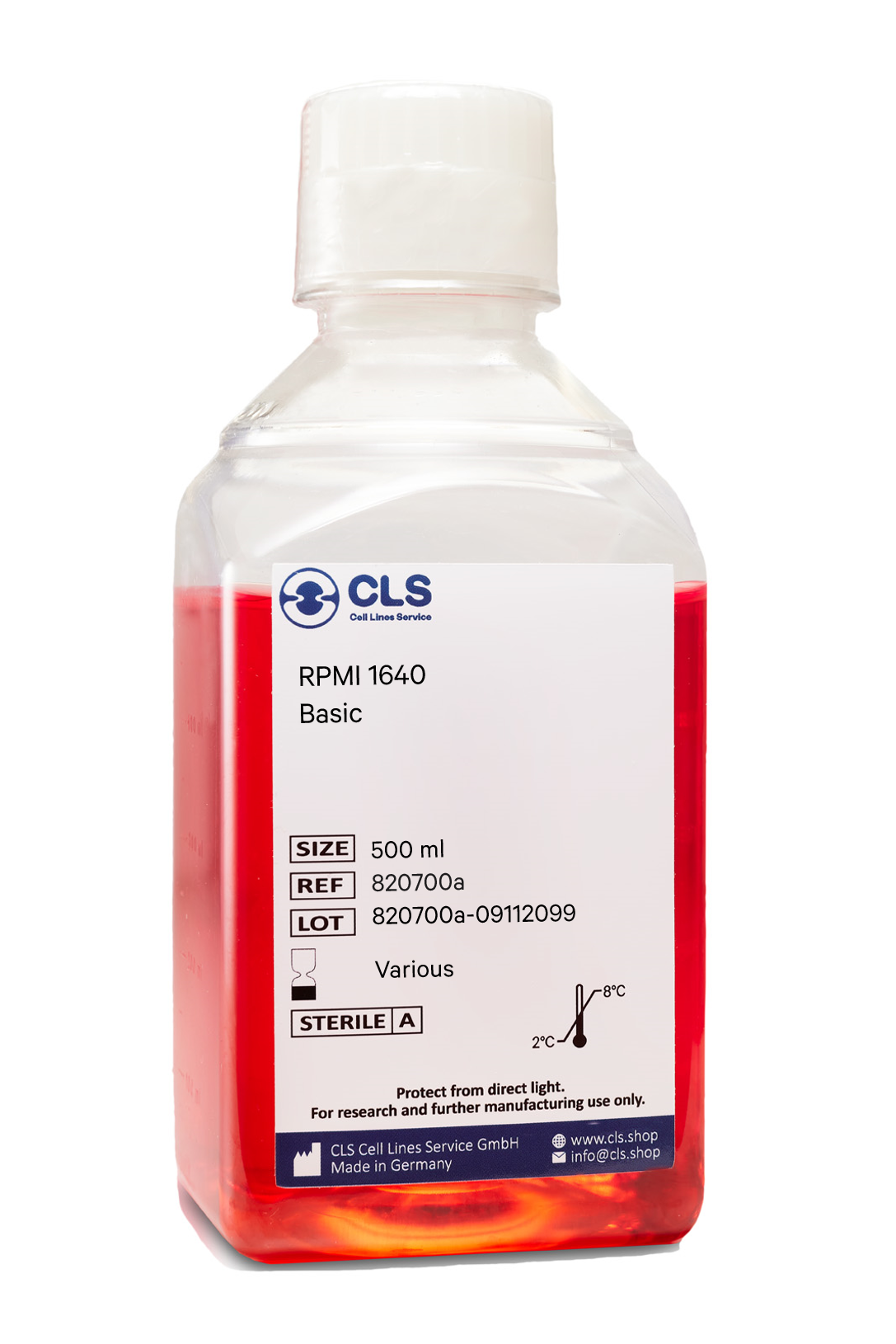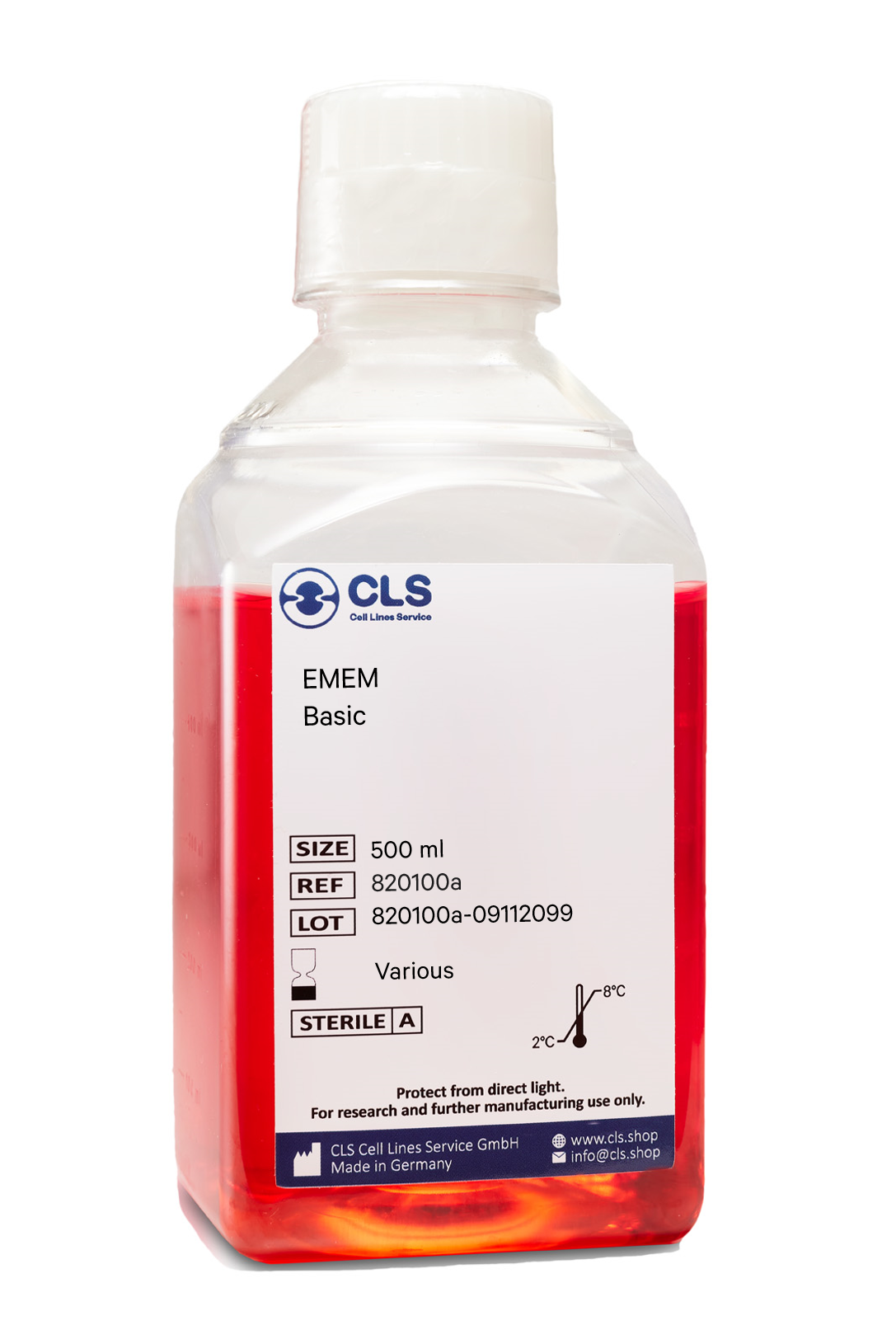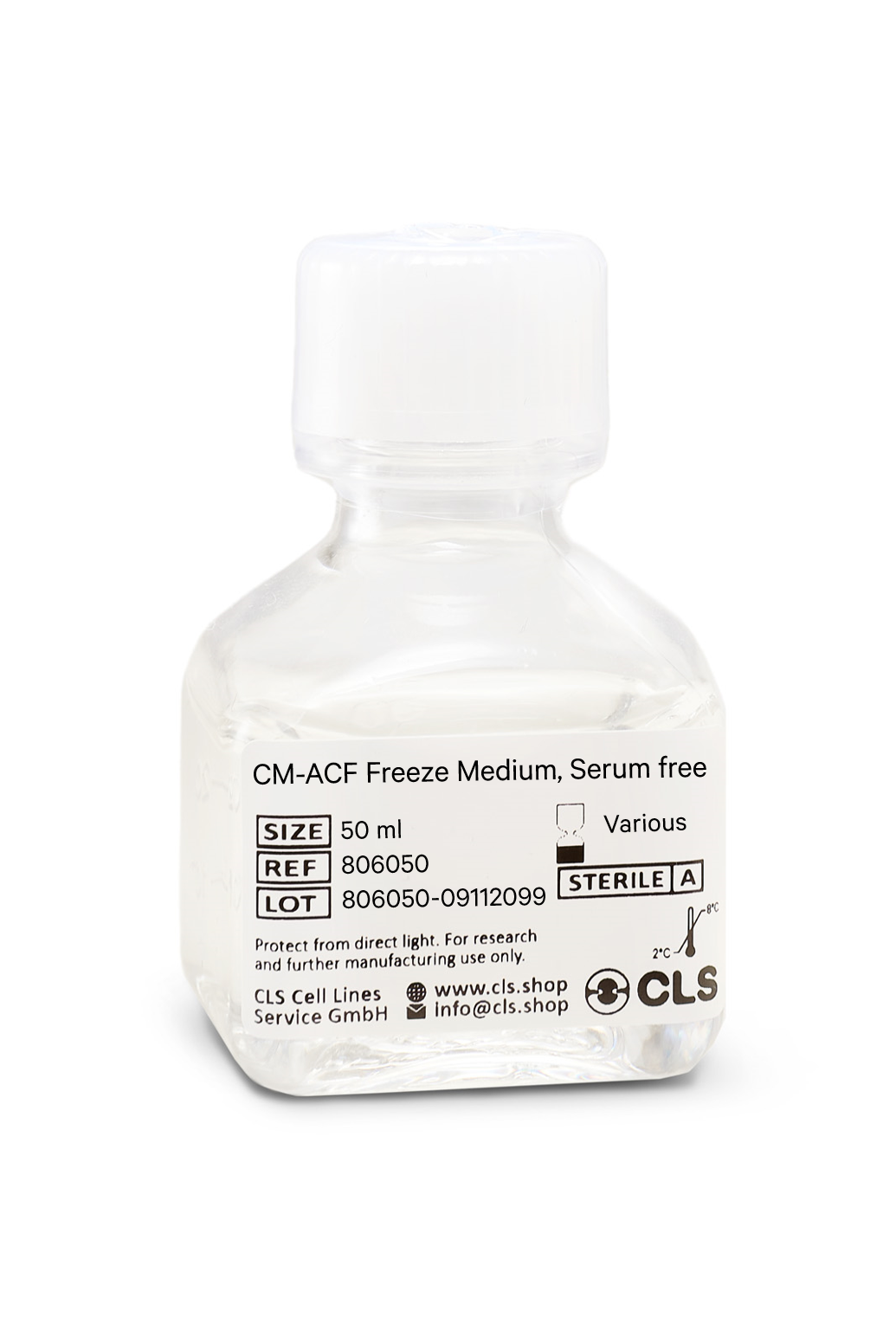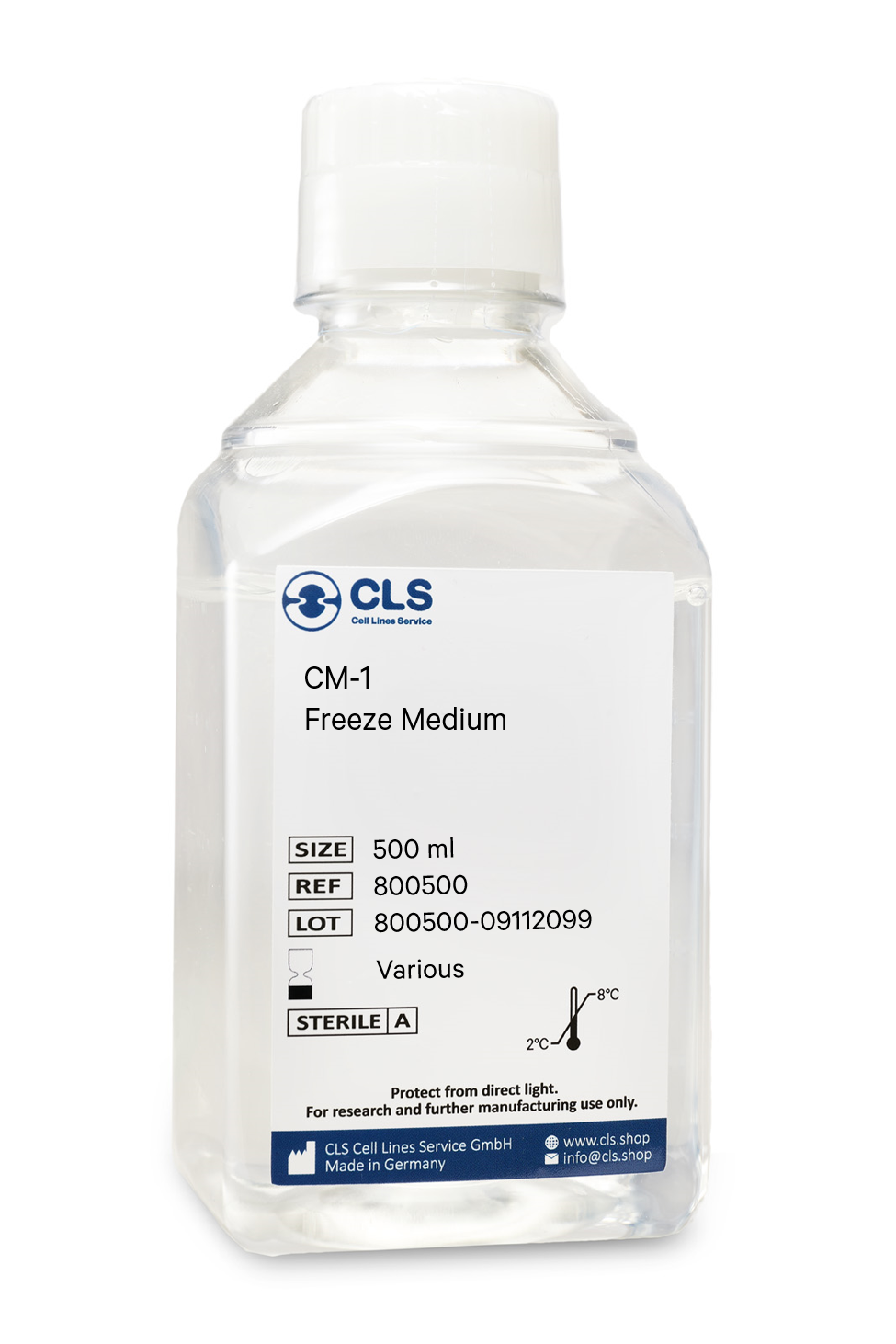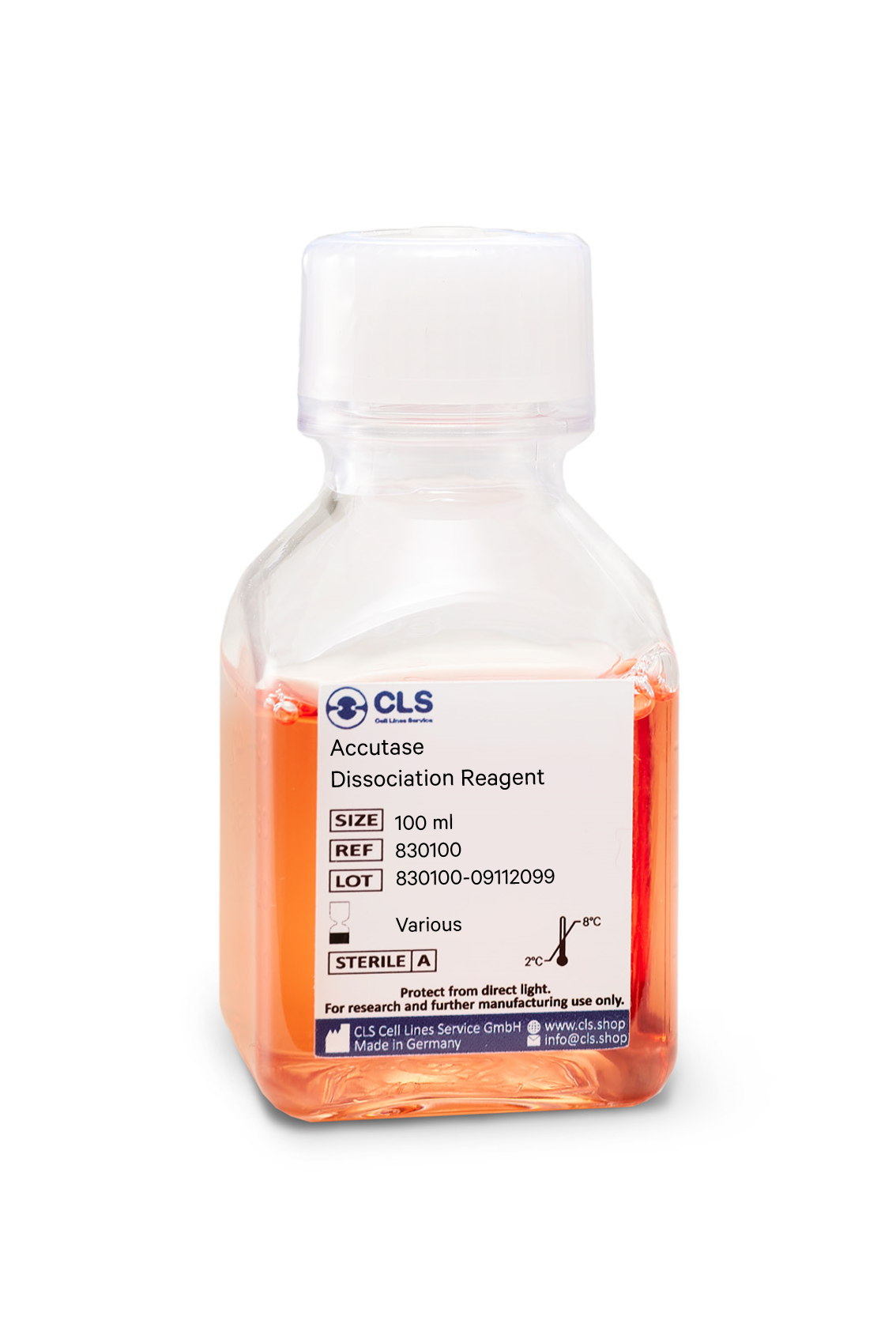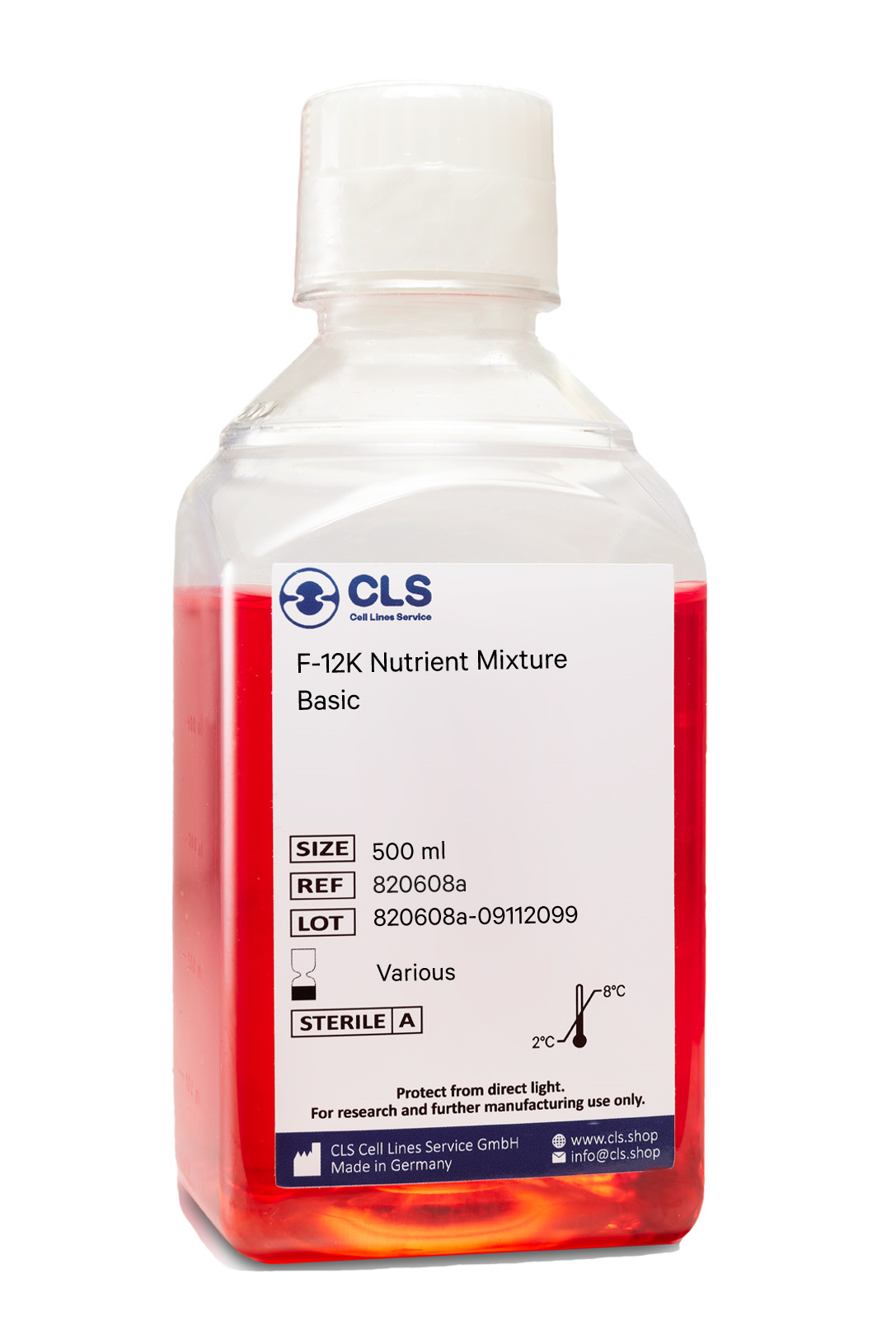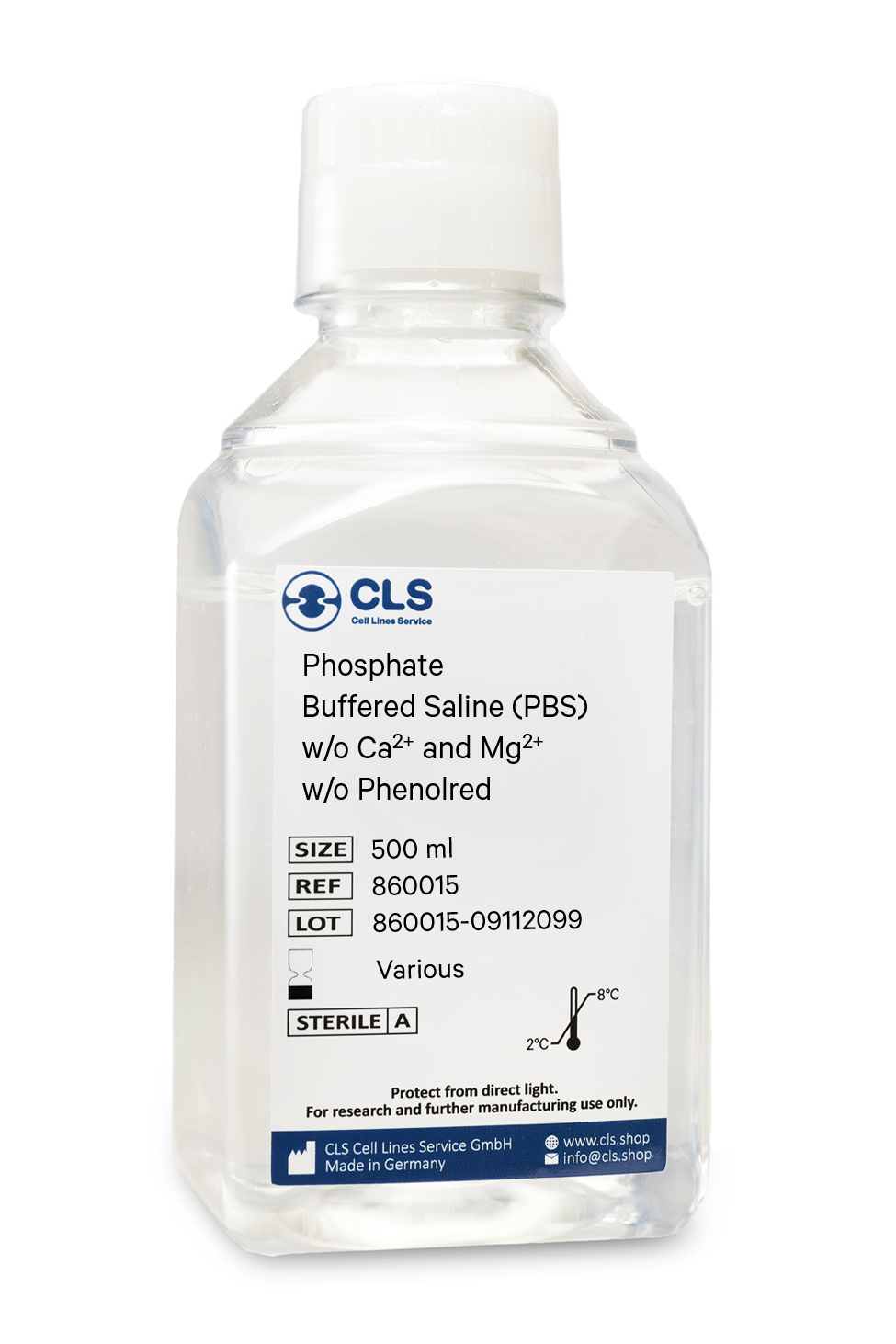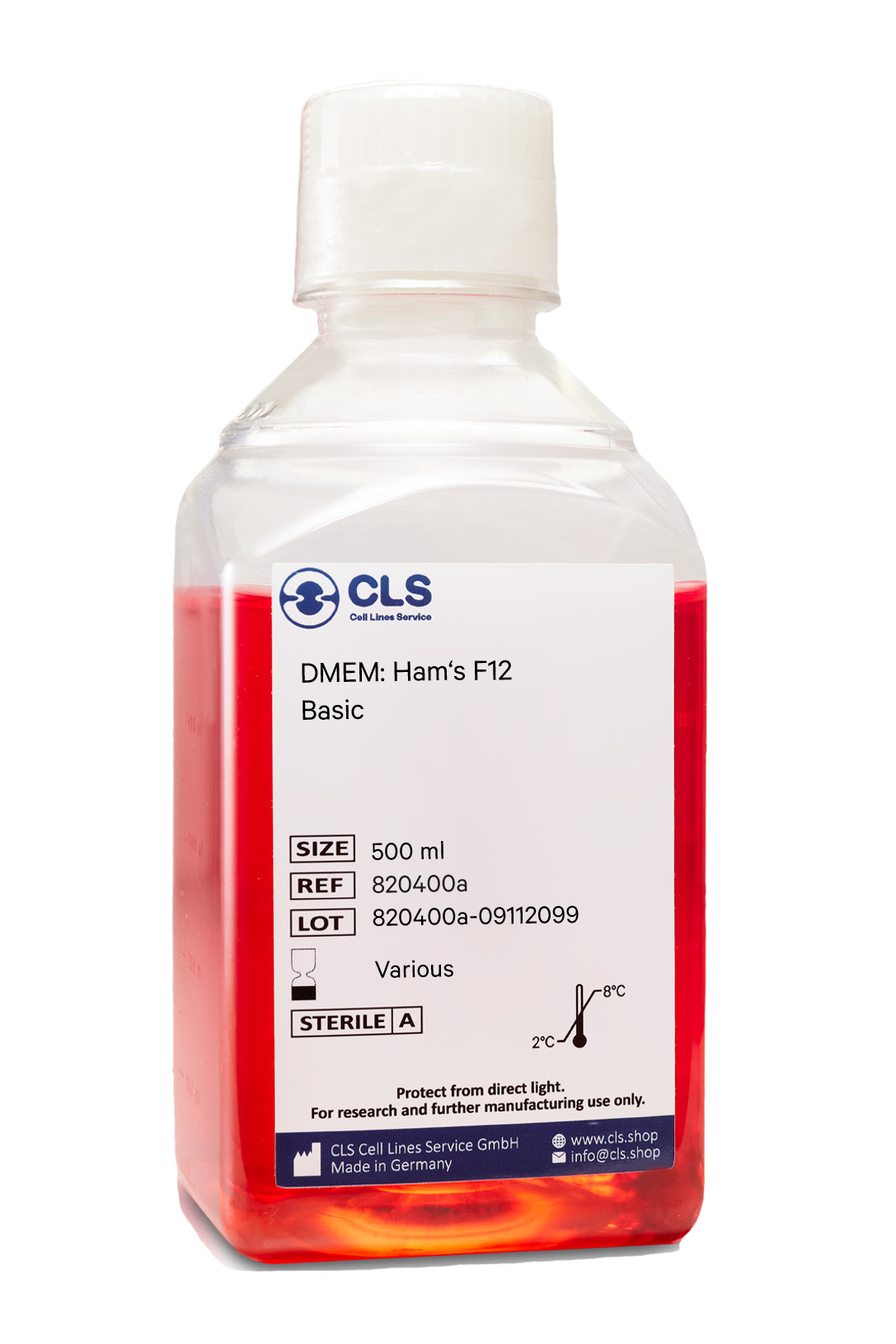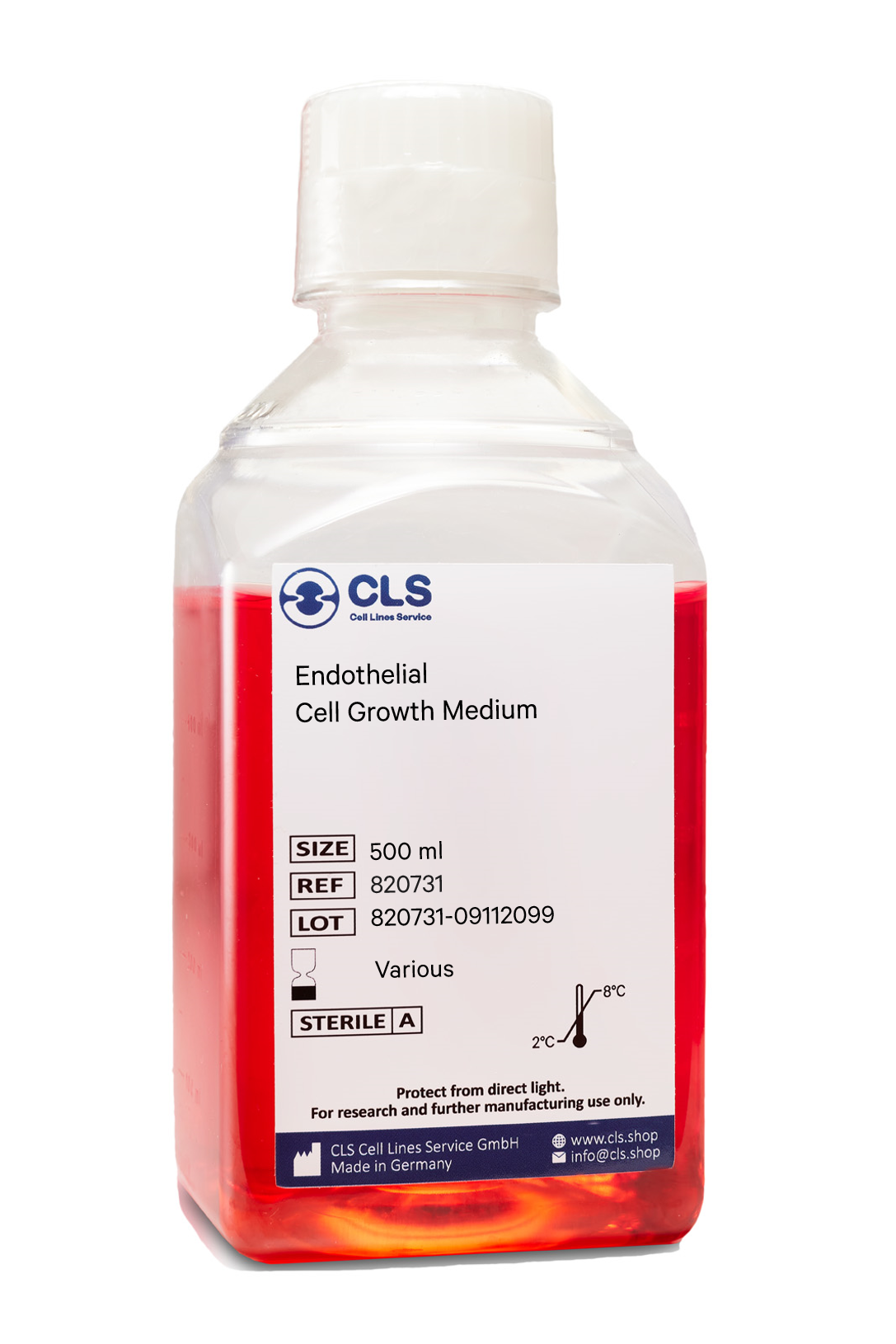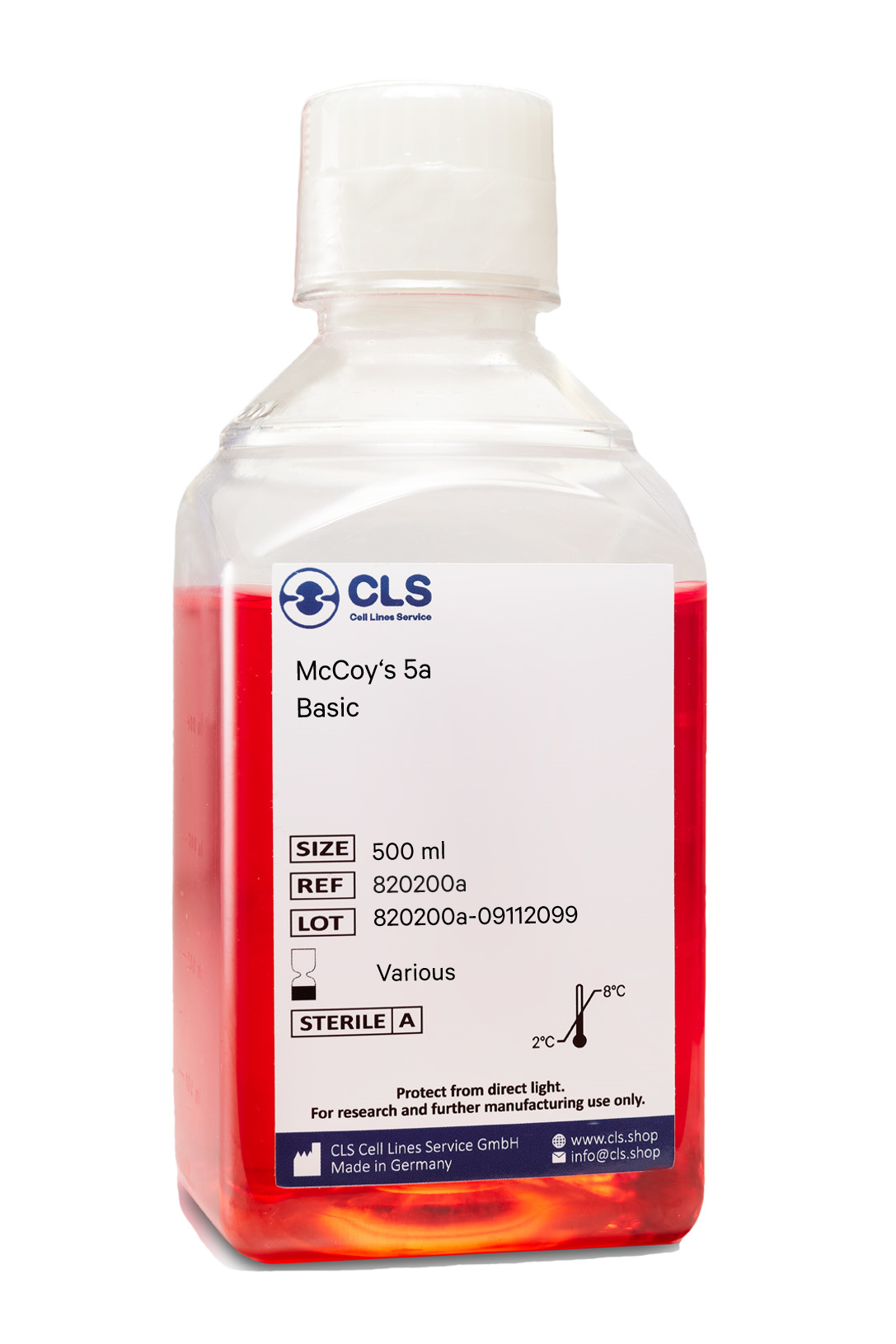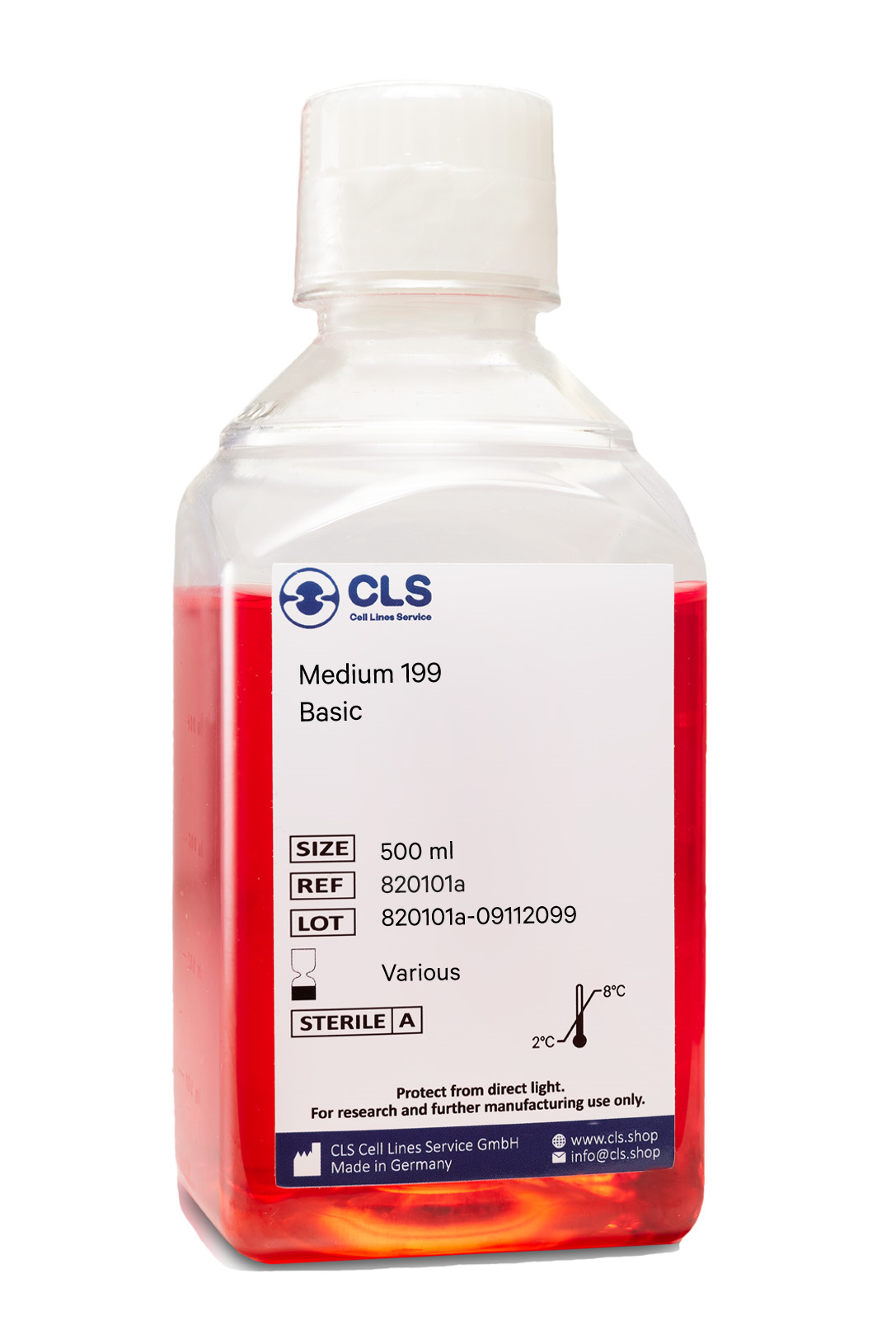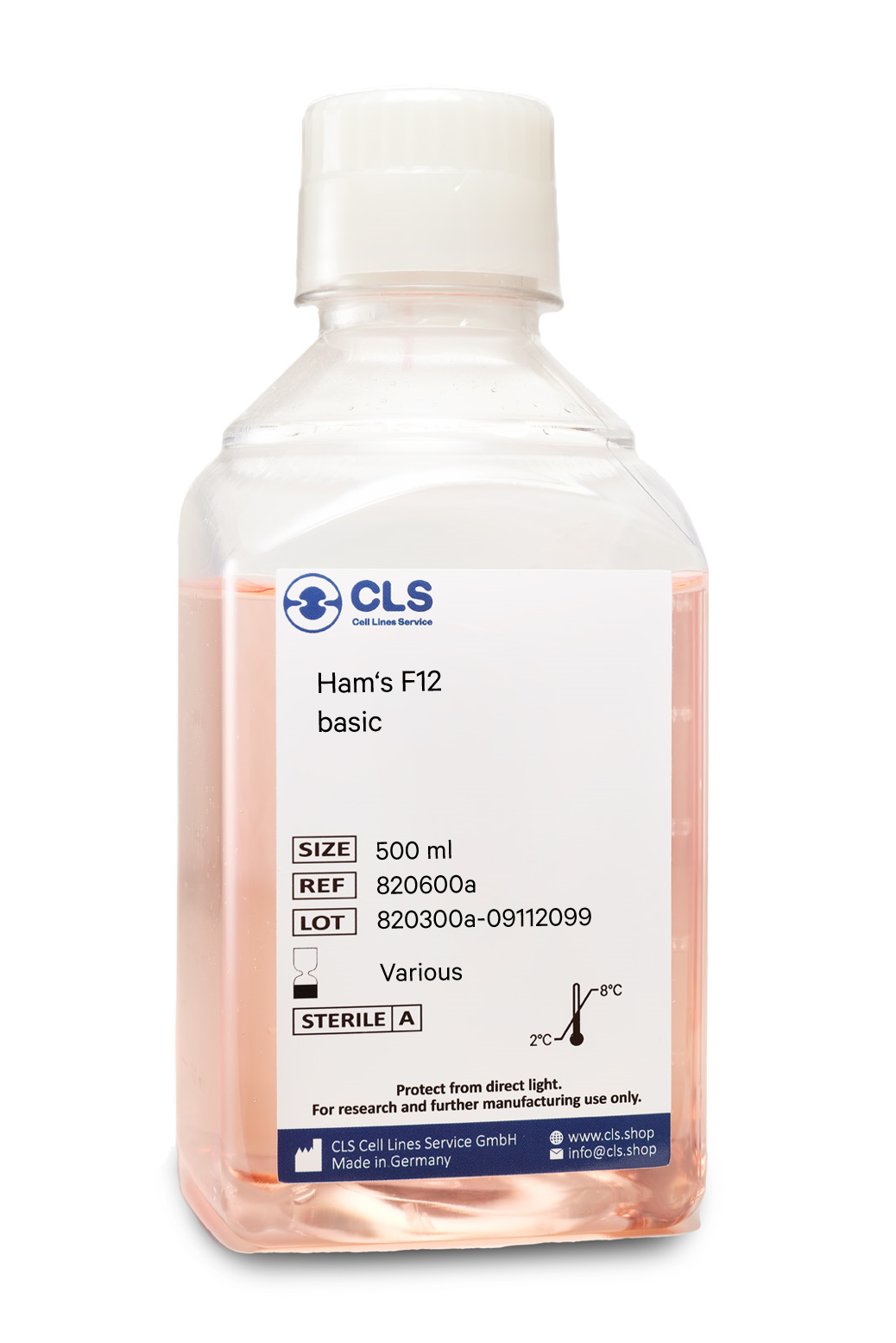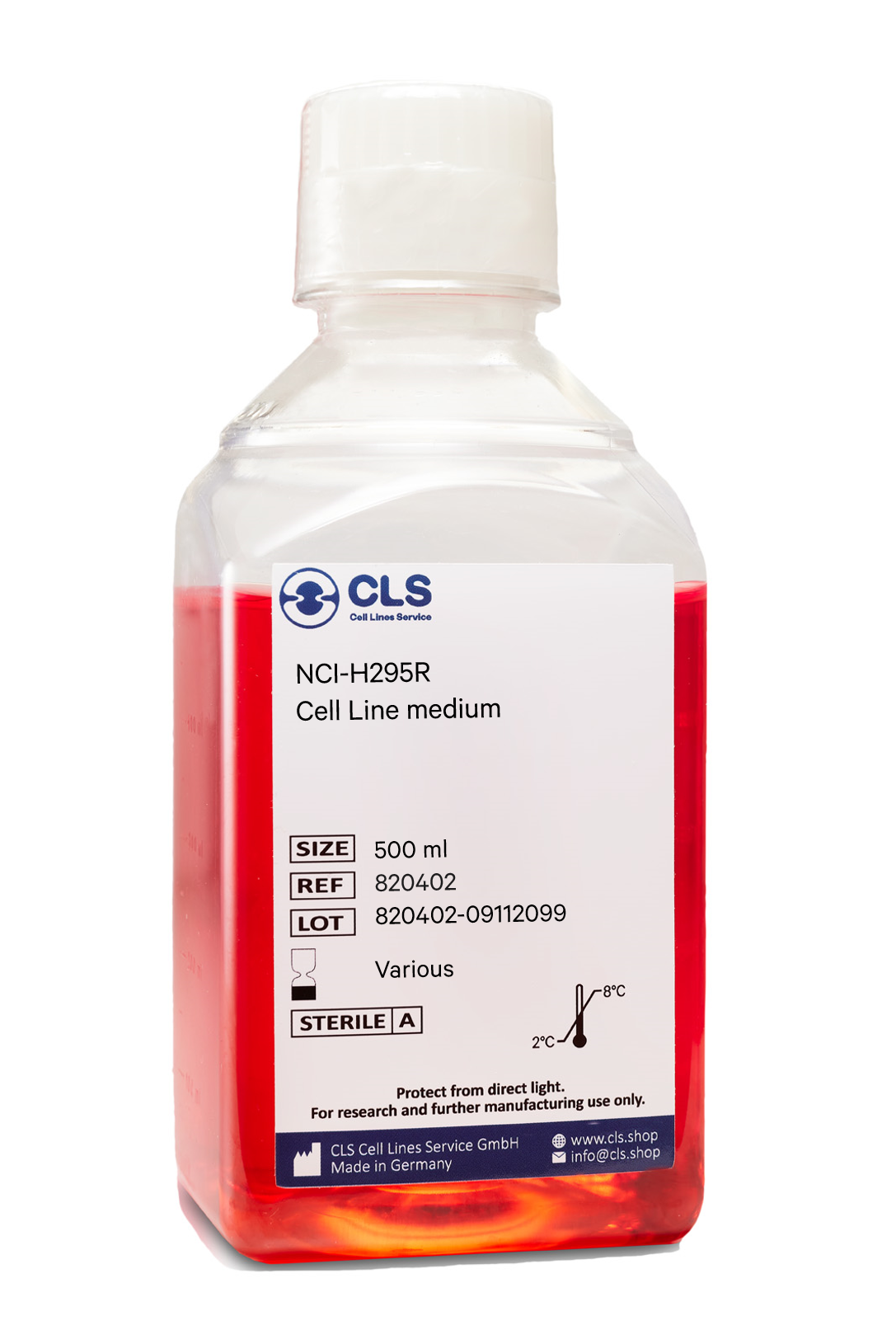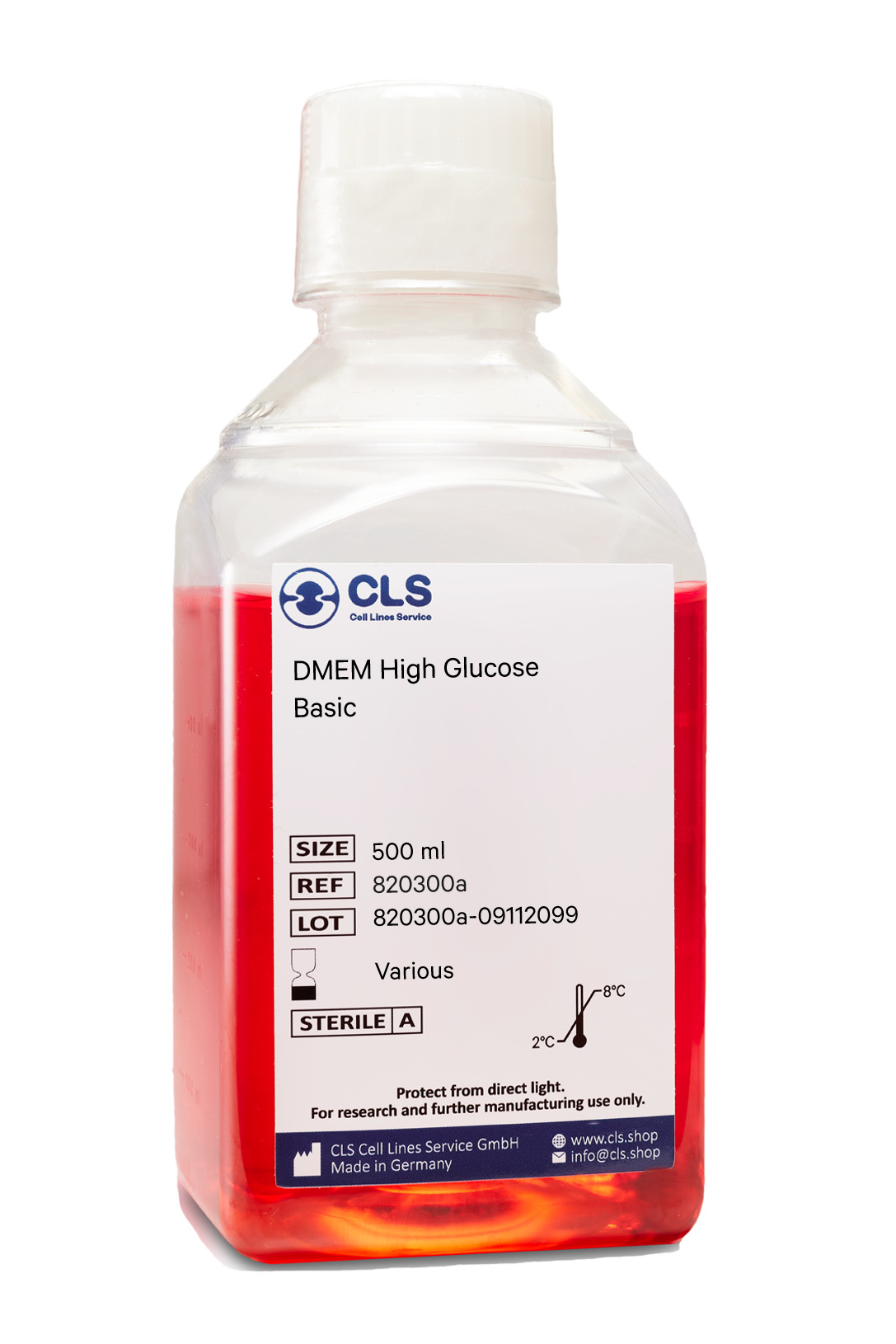Ursprünglich für das Wachstum menschlicher Leukämiezellen in Suspensions
- und Monolayer-Kulturen konzipiert, hat sich RPMI 1640 Medium durch Modifikationen von Forschern und kommerziellen Anbietern weiterentwickelt und ist heute für eine Vielzahl von Säugetierzellen geeignet. Es ist außergewöhnlich kompatibel mit Zelllinien wie HeLa, Jurkat, MCF-7, PC12, PBMC, Astrozyten und Karzinomen.
RPMI 1640 Medium hebt sich von anderen Zellkulturmedien durch seine einzigartige Zusammensetzung ab. Es enthält eine erhebliche Menge an Phosphat, Aminosäuren und Vitaminen. Insbesondere enthält es Biotin, Vitamin B12 und PABA, die in Eagle's Minimal Essential Medium oder Dulbecco's Modified Eagle Medium nicht vorhanden sind. Darüber hinaus weist RPMI 1640 Medium deutlich erhöhte Konzentrationen der Vitamine Inositol und Cholin auf. Es enthält jedoch keine Proteine, Lipide oder Wachstumsfaktoren. Daher ist in der Regel eine Ergänzung mit 10 % fötalem Rinderserum (FBS) erforderlich, um optimale Bedingungen für das Zellwachstum zu schaffen.
Das Puffersystem von RPMI 1640 Medium basiert auf Natriumbicarbonat (2,0 g/L) und erfordert eine 5-10%ige CO2-Umgebung, um einen physiologisch angemessenen pH-Wert zu erhalten. Die Zugabe des Reduktionsmittels Glutathion unterscheidet dieses Medium weiter von anderen.
Dieses RPMI 1640-Medium enthält 4,5 Gramm Glukose pro Liter.
Qualitätskontrolle
pH = 7,2 +/
- 0,02 bei 20-25°C.
Jede Charge wurde auf Sterilität und Abwesenheit von Mykoplasmen und Bakterien getestet.
Wartung
Kühl aufbewahren bei +2°C bis +8°C im Dunkeln. Einfrieren und Erwärmen bis zu +37° C mindern die Qualität des Produkts.
Erwärmen Sie das Medium nicht auf mehr als 37° C und verwenden Sie keine unkontrollierbaren Wärmequellen (z.B. Mikrowellengeräte).
Wenn nur ein Teil des Mediums verwendet werden soll, nehmen Sie diese Menge aus der Flasche und erwärmen Sie sie bei Raumtemperatur.
Die Haltbarkeit eines jeden Mediums mit Ausnahme des Basismediums beträgt 8 Wochen ab Herstellungsdatum.
Zusammensetzung
Bestandteile
mg/L
Anorganische Salze
Kalziumnitrat x 4H2O
100,00
Magnesiumsulfat wasserfrei
48,83
Kaliumchlorid
400,00
Natriumchlorid
5450,00
di-Natriumhydrogenphosphat
800,49
Sonstige Bestandteile
D(+)-Glucose wasserfrei
4500,00
Glutathion (red.)
1,00
HEPES
2383,00
Phenol rot
5,00
Natriumpyruvat
110,00
Aminosäuren
L-Arginin x HCl
241,86
L-Asparagin x H2O
56,82
L-Asparaginsäure
20,00
L-Cystin x 2HCl
65,19
L-Glutamin
300,00
L-Glutaminsäure
20,00
Glycin
10,00
L-Histidin x HCl x H2O
20,27
L-Hydroxyprolin
20,00
L-Isoleucin
50,00
L-Leucin
50,00
L-Lysin x HCl
40,00
L-Methionin
15,00
L-Phenylalanin
15,00
L-Prolin
20,00
L-Serin
30,00
L-Threonin
20,00
L-Tryptophan
5,00
L-Tyrosin x 2Na
28,83
L-Valin
20,00
Vitamine
p-Aminobenzoesäure
1,00
D-(+)-Biotin
0,20
D-Calciumpantothenat
0,25
Cholinchlorid
3,00
Folsäure
1,00
myo-Inositol
35,00
Nicotinamid
1,00
Pyridoxin x HCl
1,00
Riboflavin
0,20
Thiamin x HCl
1,00
Vitamin B12
0,01
NaHCO3
1500,00
Dieses EMEM-Medium besteht aus 2 mM L-Glutamin, 1,5 g/L NaHCO3, EBSS, 1 mM Natriumpyruvat und NEAA.
Was ist in EMEM enthalten?
EMEM ist eine modifizierte Version von Eagle's Minimum Essential Medium und enthält Earle's Balanced Salt Solution, nicht essentielle Aminosäuren, L-Glutamin, Natriumpyruvat und Natriumbicarbonat. Es ist wichtig zu beachten, dass dieser reduzierte Gehalt an Natriumbicarbonat (NaHCO3, 1,5 g/L) für die Verwendung bei 5 % CO2 in der Luft vorgesehen ist. Um seine Wirksamkeit zu erhalten, wird empfohlen, das Medium bei 2 °C bis 8 °C im Dunkeln zu lagern, wenn es nicht verwendet wird.
Wozu wird EMEM verwendet?
Eagle's minimal essential medium (EMEM) ist ein Zellkulturmedium, das Zellen in Gewebekulturen erhalten kann. Das Medium enthält höhere Konzentrationen von Aminosäuren, was eine genauere Annäherung an die Proteinzusammensetzung kultivierter Säugetierzellen ermöglicht. EMEM kann zur Kultivierung verschiedener Zellen verwendet werden, darunter Fibroblasten, menschliche Leberkrebszellen (HepG2) und Astrozytenzellen aus fötalen Gehirnvorläuferzellen (PDA). Es wird in der Regel in Gegenwart von fötalem Rinderserum (FBS), Kalbs
- oder Pferdeserum verwendet.
Wie unterscheidet sich EMEM von anderen Zellkulturmedien?
EMEM und Dulbecco's modified Eagle's medium (DMEM) haben zwar einige Gemeinsamkeiten, unterscheiden sich aber auch. Beide Medien sind proteinarm und enthalten die Aminosäuren, Salze, Glukose und Vitamine, die erforderlich sind, um eine Zelle mit Energie zu versorgen und sie in der Gewebekultur zu erhalten. Die DMEM-Formulierung ist jedoch so modifiziert, dass sie bis zu viermal mehr Vitamine und Aminosäuren und zwei
- bis viermal mehr Glukose enthält als EMEM. Es sei darauf hingewiesen, dass sich EMEM auch von der ursprünglichen MEM-Formulierung unterscheidet.
Qualitätskontrolle
pH = 7,2 +/
- 0,02 bei 20-25°C.
Jede Charge wurde auf Sterilität und Abwesenheit von Mykoplasmen und Bakterien getestet.
Wartung
Gekühlt bei +2°C bis +8°C im Dunkeln aufbewahren. Einfrieren und Erwärmen bis zu +37° C mindern die Qualität des Produkts.
Erwärmen Sie das Medium nicht auf mehr als 37° C und verwenden Sie keine unkontrollierbaren Wärmequellen (z.B. Mikrowellengeräte).
Wenn nur ein Teil des Mediums verwendet werden soll, nehmen Sie diese Menge aus der Flasche und erwärmen Sie sie bei Raumtemperatur.
Die Haltbarkeit eines jeden Mediums mit Ausnahme des Basismediums beträgt 8 Wochen ab dem Herstellungsdatum.
Zusammensetzung
Bestandteile
mg/L
Anorganische Salze
Calciumchlorid x 2H2O
264,92
Magnesium-Sulfat
97,67
Kaliumchlorid
400,00
Natriumchlorid
6,800.00
Natriumdihydrogenphosphat x H2O
140,00
Sonstige Bestandteile
D(+)-Glucose
1,000.00
Phenolrot
10,00
Natriumpyruvat
110,00
NaHCO3
1,500.00
Aminosäuren
L-Alanin
8,90
L-Arginin x HCl
126,00
L-Asparagin x H2O
13,20
L-Asparaginsäure
13,30
L-Cystin
24,00
L-Glutamin
292,30
L-Glutaminsäure
14,70
Glycin
7,50
L-Histidin x HCl x H2O
42,00
L-Isoleucin
52,00
L-Leucin
52,00
L-Lysin x HCl
72,50
L-Methionin
15,00
L-Phenylalanin
32,00
L-Prolin
11,50
L-Serin
10,50
L-Threonin
48,00
L-Tryptophan
10,00
L-Tyrosin
36,00
L-Valin
46,00
Vitamine
D-Calciumpantothenat
1,00
Cholinchlorid
1,00
Folsäure
1,00
myo-Inositol
2,00
Nicotinamid
1,00
Pyridoxal x HCl
1,00
Riboflavin
0,10
Thiamin x HCl
1,00
In der biologischen Forschung ist die Kryokonservierung von Säugetierzellen ein unschätzbares Instrument. Die erfolgreiche Konservierung von Zellen hat oberste Priorität, da der Verlust einer Zelllinie durch Kontamination oder unsachgemäße Lagerungsbedingungen zu Zeit
- und Geldverlusten führt und letztlich die Forschungsergebnisse verzögert. Sobald die Zellen von einem Zellwachstumsmedium in ein Gefriermedium überführt worden sind, werden sie in der Regel mit einer geregelten Geschwindigkeit eingefroren und in flüssigem Stickstoffdampf oder bei unter -130°C in einem mechanischen Tiefkühlschrank gelagert. Das Einfriermedium CM-ACF ermöglicht die Kryokonservierung von Zellen bei unter -130°C (oder in flüssigem Stickstoff), wodurch ein zusätzlicher, kostspieliger Ultratiefkühlschrank überflüssig wird und zeitaufwändige und anspruchsvolle Einfrierprozesse mit kontrollierter Rate entfallen. Die Zellen werden einfach entnommen, das Wachstumsmedium abgesaugt, in CM-ACF resuspendiert, in ein Kryovial überführt und bei einer Temperatur von unter -130 °C gelagert.
Lange Haltbarkeitsdauer
CM-ACF ist ein serumfreies, gebrauchsfertiges Kryokonservierungsmedium, das bis zu einem Jahr im Kühlschrank gelagert werden kann.
Hunderte von Forschern vertrauen darauf
Unser fortschrittliches, serumfreies Zelleinfriermedium CM-ACF ist ein marktführendes Produkt in Deutschland und Europa und zeichnet sich durch zahlreiche Publikationen mit Hunderten von verschiedenen Zelllinien weltweit aus. Wir haben es mit mehr als 1000 Zelllinien aus unserer firmeneigenen Zellbank getestet.
Optimierte serumfreie Inhaltsstoffe
CM-ACF enthält keine Serumprodukte. Serumhaltige Kryokonservierungsmedien haben den Nachteil schwankender Rückgewinnungsraten und unklarer Zusammensetzung. Da die Zusammensetzung und Konzentration von Proteinen und anderen biologischen Komponenten im Serum von Charge zu Charge variiert, kann die Reproduzierbarkeit von Experimenten mit Zellen, die in einem serumhaltigen Medium eingefroren wurden, beeinträchtigt sein. Da jeder Bestandteil von CM-ACF sorgfältig definiert ist, können Sie sich darauf verlassen, dass sich die Zellen immer auf die gleiche Weise erholen.
Enthält DMSO, Glukose, Salze
Pufferkapazität pH = 7,2 bis 7,6
Universell
- auch für die Stammzellkonservierung
Alle gängigen Zelllinien können eingefroren und aufgetaut werden, um viele lebensfähige Zellen zu erhalten. Im Vergleich zu Standardmedien ist die Rückgewinnungsrate selbst bei den empfindlichsten Zellen deutlich höher. Mit CM-ACF lagern wir über 1000 verschiedene Zelllinien mit hervorragendem Erfolg.
Anwendungen & Validierung
Die in unserem CM-ACF Einfriermedium konservierten Zellen können für die Zellzählung, Lebensfähigkeit und Kryokonservierung, Zellkultur, Säugetierzellkultur, Genexpressionsanalyse und Genotypisierung, In-vitro-Transkription und Polymerase-Kettenreaktionen verwendet werden. Die Wirksamkeit jeder Charge wird anhand von CHO-K1-Zellen bewertet. Jede Charge wird auf pH-Wert, Osmolalität, Sterilität und Endotoxine getestet, um eine hohe Qualität zu gewährleisten.
In der biologischen Forschung ist die Kryokonservierung von Säugetierzellen ein unschätzbares Instrument. Die erfolgreiche Konservierung von Zellen hat oberste Priorität, da der Verlust einer Zelllinie durch Kontamination oder unsachgemäße Lagerungsbedingungen zu Zeit
- und Geldverlusten führt und letztlich die Forschungsergebnisse verzögert. Sobald die Zellen von einem Zellwachstumsmedium in ein Einfriermedium überführt wurden, werden sie in der Regel mit einer geregelten Geschwindigkeit eingefroren und in flüssigem Stickstoffdampf oder bei unter -130°C in einem mechanischen Tiefkühlschrank gelagert. Das Einfriermedium CM-1 ermöglicht die Kryokonservierung von Zellen bei unter -130°C (oder in flüssigem Stickstoff), wodurch ein zusätzlicher, kostspieliger Ultratiefkühlschrank überflüssig wird und zeitaufwändige und anspruchsvolle Einfrierprozesse mit kontrollierter Rate entfallen. Die Zellen werden einfach entnommen, das Wachstumsmedium abgesaugt, in CM-1 resuspendiert, in ein Kryovial überführt und bei einer Temperatur von unter -130 °C gelagert.
Lange Haltbarkeitsdauer
CM-1 ist ein serumhaltiges, gebrauchsfertiges Kryokonservierungsmedium, das bis zu einem Jahr im Kühlschrank gelagert werden kann.
Hunderte von Forschern vertrauen darauf
Unser fortschrittliches Zelleinfriermedium CM-1 ist ein marktführendes Produkt in Deutschland und Europa und zeichnet sich durch zahlreiche Publikationen mit Hunderten von verschiedenen Zelllinien weltweit aus. Wir haben es mit mehr als 1000 Zelllinien aus unserer firmeneigenen Zellbank getestet.
Optimierte Inhaltsstoffe
CM-1 enthält Serumprodukte. Serumhaltige Kryokonservierungsmedien schützen die Zellen während des Einfrierens optimal und haben den Vorteil einer hohen Rückgewinnungsrate. Da CM-1 mit einer Vielzahl von Zelllinien getestet wurde, können Sie sich darauf verlassen, dass sich Ihre Zellen immer gut erholen.
Enthält FBS, DMSO, Glukose, Salze
Pufferkapazität pH = 7,2 bis 7,6
Anwendungen & Validierung
Die in unserem Einfriermedium CM-1 konservierten Zellen können für die Zellzählung, Lebensfähigkeit und Kryokonservierung, Zellkultur, Säugetierzellkultur, Genexpressionsanalyse und Genotypisierung, In-vitro-Transkription und Polymerase-Kettenreaktionen verwendet werden. Die Wirksamkeit jeder Charge wird anhand von CHO-K1-Zellen bewertet. Jede Charge wird auf pH-Wert, Osmolalität, Sterilität und Endotoxine getestet, um eine hohe Qualität zu gewährleisten.
- eine schonende Alternative zu Trypsin
Accutase ist eine Zellablösungslösung, die die Zellkulturindustrie revolutioniert. Es ist eine Mischung aus proteolytischen und kollagenolytischen Enzymen, die die Wirkung von Trypsin und Kollagenase nachahmt. Im Gegensatz zu Trypsin enthält Accutase keine Säugetier
- oder Bakterienbestandteile und ist sehr viel schonender für die Zellen, was es zu einer idealen Lösung für die routinemäßige Ablösung von Zellen von Standardplastikgefäßen für die Gewebekultur und adhäsionsbeschichteten Plastikgefäßen macht. In diesem Blogbeitrag gehen wir auf die Vorteile und Einsatzmöglichkeiten von Accutase ein und zeigen, wie es die Zellkultur verändert.
Vorteile von Accutase
Accutase hat mehrere Vorteile gegenüber herkömmlichen Trypsinlösungen. Erstens kann es immer dann eingesetzt werden, wenn eine sanfte und effiziente Ablösung von adhärenten Zelllinien erforderlich ist, und ist somit ein direkter Ersatz für Trypsin. Zweitens funktioniert Accutase sehr gut bei embryonalen und neuronalen Stammzellen, und es hat sich gezeigt, dass die Lebensfähigkeit dieser Zellen nach der Passage erhalten bleibt. Drittens bewahrt Accutase die meisten Epitope für die anschließende durchflusszytometrische Analyse, was es ideal für die Analyse von Zelloberflächenmarkern macht.
Außerdem muss Accutase bei der Passage von adhärenten Zellen nicht neutralisiert werden. Durch die Zugabe weiterer Medien nach der Zellteilung wird die Accutase verdünnt, so dass sie nicht mehr in der Lage ist, Zellen abzulösen. Dadurch entfällt der Schritt der Inaktivierung, und die Zellkulturtechniker sparen Zeit. Schließlich muss Accutase nicht aliquotiert werden, und eine Flasche ist im Kühlschrank 2 Monate lang haltbar.
Anwendungen von Accutase
Accutase ist ein direkter Ersatz für Trypsinlösung und kann für die Passage von Zelllinien verwendet werden. Darüber hinaus eignet sich Accutase gut zum Ablösen von Zellen für die Analyse vieler Zelloberflächenmarker mittels Durchflusszytometrie und für die Zellsortierung. Andere nachgeschaltete Anwendungen der Accutase-Behandlung umfassen die Analyse von Zelloberflächenmarkern, Viruswachstumstests, Zellproliferation, Tumorzellmigrationsassays, routinemäßige Zellpassage, Produktionsskalierung (Bioreaktor) und Durchflusszytometrie.
Zusammensetzung von Accutase
Accutase enthält keine Bestandteile von Säugetieren oder Bakterien und ist eine natürliche Enzymmischung mit proteolytischer und kollagenolytischer Enzymaktivität. Es ist in einer viel niedrigeren Konzentration als Trypsin und Kollagenase formuliert, wodurch es weniger toxisch und sanfter, aber genauso wirksam ist.
Wirksamkeit von Accutase
Accutase ist nachweislich effizient bei der Ablösung von Primär
- und Stammzellen und erhält die hohe Lebensfähigkeit der Zellen im Vergleich zu Enzymen tierischen Ursprungs wie Trypsin. 100 % der Zellen werden nach 10 Minuten zurückgewonnen, und dank der Selbstverdauung von Accutase ist es unbedenklich, Zellen bis zu 45 Minuten in Accutase zu belassen.
Zusammenfassung
Zusammenfassend lässt sich sagen, dass Accutase eine leistungsstarke Lösung ist, die das Spiel in der Zellkultur verändert. Mit seiner sanften Natur, Effizienz und Vielseitigkeit ist Accutase die ideale Alternative zu Trypsin. Wenn Sie nach einer zuverlässigen und effizienten Lösung für die Zellablösung suchen, ist Accutase die richtige Lösung für Sie.
- und Hühnerleberzellen, insbesondere unter serumreduzierten Bedingungen.
Ham's F-12K (Kaighn's) Medium ist sorgfältig formuliert, um die Zellkulturbedingungen zu optimieren. Es zeichnet sich durch eine angereicherte Zusammensetzung aus, die einen erhöhten Gehalt an essenziellen Komponenten wie Aminosäuren und Natriumpyruvat sowie zusätzliche Elemente wie Putrescin, Thymidin, Hypoxanthin und Zink enthält. Diese Zusätze ermöglichen es den Forschern, das Medium mit einem Minimum an Serum oder definierten Komponenten für bestimmte Zelltypen zu ergänzen und so präzise Versuchsbedingungen zu schaffen.
Insbesondere enthält Ham's F-12K (Kaighn's) Medium keine Proteine oder Wachstumsfaktoren. Daher ist häufig eine Ergänzung mit Wachstumsfaktoren und fötalem Rinderserum (FBS) erforderlich, so dass die Forscher das Medium an die Anforderungen ihrer spezifischen Zelllinien anpassen können. Um eine optimale Leistung zu erzielen, muss die FBS-Konzentration für jede Zelllinie sorgfältig optimiert werden, um optimales Wachstum und Funktionalität zu gewährleisten.
Um den physiologischen pH-Wert aufrechtzuerhalten, verwendet das Ham's F-12K (Kaighn's) Medium ein Natriumbicarbonat-Puffersystem (2,5 g/L), das während der Kultivierung eine kontrollierte 5-10%ige CO2-Umgebung erfordert. Dadurch wird sichergestellt, dass der pH-Wert des Mediums innerhalb des idealen Bereichs für das Wachstum und die Lebensfähigkeit der Zellen bleibt
Qualitätskontrolle
pH = 7,2 +/
- 0,02 bei 20-25°C.
Jede Charge wurde auf Sterilität und Abwesenheit von Mykoplasmen und Bakterien getestet.
Wartung
Kühl aufbewahren bei +2°C bis +8°C im Dunkeln. Sowohl das Einfrieren als auch das Erwärmen auf bis zu +37°C mindern die Qualität des Produkts.
Erwärmen Sie das Medium nicht auf mehr als 37°C und verwenden Sie keine unkontrollierbaren Wärmequellen (z.B. Mikrowellengeräte).
Wenn nur ein Teil des Mediums verwendet werden soll, nehmen Sie diese Menge aus der Flasche und erwärmen Sie sie bei Raumtemperatur.
Mit Ausnahme des Basismediums ist jedes Medium 8 Wochen ab Herstellungsdatum haltbar.
Zusammensetzung
Bestandteile
mg/L
Anorganische Salze
Calciumchlorid x 2H2O
135,24
Kupfer(II)-sulfat x 5H2O
0,00
Eisen(II)-sulfat x 7H2O
0,83
Magnesiumchlorid x 6H2O
105,72
Magnesiumsulfat x 7H2O
394,49
Kaliumchlorid
283,29
Kaliumdihydrogenphosphat
58,52
Natriumchlorid
7597,20
di-Natriumhydrogenphosphatwasserfrei
115,02
Zinksulfat x 7H2O
0,14
Sonstige Bestandteile
D(+)-Glucose wasserfrei
1260,00
Hypoxanthin
4,08
DL-α-Liponsäure
0,21
Rotes Phenol
3,00
Putrescin x 2HCl
0,32
Natriumpyruvat
220,00
NaHCO3
2500,00
Thymidin
0,73
Aminosäuren
L-Alanin
17,82
L-Arginin x HCl
421,40
L-Asparagin x H2O
30,02
L-Asparaginsäure
26,62
L-Cystein x HCl x H2O
70,24
L-Glutamin
292,20
L-Glutaminsäure
29,42
Glycin
15,01
L-Histidin x HCl x H2O
41,92
L-Isoleucin
7,87
L-Leucin
26,24
L-Lysin x HCl
73,04
L-Methionin
8,95
L-Phenylalanin
9,91
L-Prolin
69,06
L-Serin
21,02
L-Threonin
23,82
L-Tryptophan
4,08
L-Tyrosin
10,87
L-Valin
23,42
Vitamine
D(+)-Biotin
0,07
D-Calciumpantothenat
0,48
Cholinchlorid
13,96
Folsäure
1,32
myo-Inositol
18,02
Nicotinamid
0,04
Pyridoxin x HCl
0,06
Riboflavin
0,04
Thiamin x HCl
0,34
Vitamin B12
1,36
Phosphatgepufferte Kochsalzlösung (PBS) ist eine vielseitige Pufferlösung, die in vielen biologischen und chemischen Anwendungen sowie bei der Gewebeverarbeitung eingesetzt wird. Unsere PBS-Lösung ist mit hochwertigen Inhaltsstoffen formuliert, um einen konstanten pH-Wert während der Experimente zu gewährleisten. Die Osmolarität und die Ionenkonzentration unserer PBS-Lösung sind auf die des menschlichen Körpers abgestimmt, so dass sie isotonisch und für die meisten Zellen nicht toxisch ist.
Zusammensetzung unserer PBS-Lösung
Unsere PBS-Lösung ist eine pH-angepasste Mischung aus hochreinen Phosphatpuffern und Kochsalzlösungen. Bei einer 1fachen Arbeitskonzentration enthält sie 137 mM NaCl, 2,7 mM KCl, 8 mM Na2HPO4 und 2 mM KH2PO4. Wir haben diese Zusammensetzung auf der Grundlage von CSHL-Protokollen und der Molekularen Klonierung nach Sambrook gewählt, die in der Forschungsgemeinschaft etablierte Standards sind.
Anwendungen unserer PBS-Lösung
Unsere PBS-Lösung ist ideal für eine Vielzahl von Anwendungen in der biologischen Forschung. Aufgrund ihrer isotonischen und ungiftigen Eigenschaften eignet sie sich perfekt für die Verdünnung von Substanzen und das Spülen von Zellbehältern. Unsere PBS-Lösung mit EDTA kann auch zum Lösen von angehefteten und verklumpten Zellen verwendet werden. Es ist jedoch wichtig zu beachten, dass zweiwertige Metalle wie Zink nicht zu PBS hinzugefügt werden dürfen, da dies zu Ausfällungen führen kann. In solchen Fällen werden Good's Puffer empfohlen. Darüber hinaus hat sich unsere PBS-Lösung als akzeptable Alternative zu viralen Transportmedien für den Transport und die Lagerung von RNA-Viren, wie z. B. SARS-CoV-2, erwiesen.
Lagerung unserer PBS-Lösung
Unsere PBS-Lösung kann bei Raumtemperatur gelagert werden und ist somit leicht zu verwenden und zugänglich.
Zusammenfassend
Zusammenfassend lässt sich sagen, dass unsere PBS-Lösung bei vielen biologischen und chemischen Experimenten ein wesentlicher Bestandteil ist. Aufgrund ihrer isotonischen und ungiftigen Eigenschaften eignet sie sich für zahlreiche Anwendungen, von der Zellkultur bis zum Virustransportmedium. Durch die Wahl unserer hochwertigen PBS-Lösung können Forscher ihre Experimente optimieren und genaue und zuverlässige Ergebnisse erzielen.
Zusammensetzung
Bestandteile
mg/L
Anorganische Salze
Kaliumchlorid
200,00
Kaliumdihydrogenphosphat
200,00
Natriumchlorid
8,000.00
di-Natriumhydrogenphosphat wasserfrei
1,150.00
Ursprünglich für das Wachstum menschlicher Leukämiezellen in Suspensions
- und Monolayer-Kulturen konzipiert, hat sich RPMI 1640 Medium durch Modifikationen von Forschern und kommerziellen Anbietern weiterentwickelt und ist heute für eine Vielzahl von Säugetierzellen geeignet. Es ist außergewöhnlich kompatibel mit Zelllinien wie HeLa, Jurkat, MCF-7, PC12, PBMC, Astrozyten und Karzinomen.
RPMI 1640 Medium hebt sich von anderen Zellkulturmedien durch seine einzigartige Zusammensetzung ab. Es enthält eine erhebliche Menge an Phosphat, Aminosäuren und Vitaminen. Insbesondere enthält es Biotin, Vitamin B12 und PABA, die in Eagle's Minimal Essential Medium oder Dulbecco's Modified Eagle Medium nicht vorhanden sind. Darüber hinaus weist RPMI 1640 Medium deutlich erhöhte Konzentrationen der Vitamine Inositol und Cholin auf. Es enthält jedoch keine Proteine, Lipide oder Wachstumsfaktoren. Daher ist in der Regel eine Ergänzung mit 10 % fötalem Rinderserum (FBS) erforderlich, um optimale Bedingungen für das Zellwachstum zu schaffen.
Das Puffersystem von RPMI 1640 Medium basiert auf Natriumbicarbonat (2,0 g/L) und erfordert eine 5-10%ige CO2-Umgebung, um einen physiologisch angemessenen pH-Wert zu erhalten. Durch die Zugabe des Reduktionsmittels Glutathion unterscheidet sich dieses Medium weiter von anderen.
Die einzigartige Zusammensetzung dieser RPMI-Formulierung umfasst 2,1 mM stabiles Glutamin, 2,0 Gramm pro Liter NaHCO3 und Phenolrot.
Qualitätskontrolle
pH = 7,2 +/
- 0,02 bei 20-25°C.
Jede Charge wurde auf Sterilität und Abwesenheit von Mykoplasmen und Bakterien getestet.
Wartung
Kühl aufbewahren bei +2°C bis +8°C im Dunkeln. Einfrieren und Erwärmen bis zu +37° C mindern die Qualität des Produkts.
Erwärmen Sie das Medium nicht auf mehr als 37° C und verwenden Sie keine unkontrollierbaren Wärmequellen (z.B. Mikrowellengeräte).
Wenn nur ein Teil des Mediums verwendet werden soll, nehmen Sie diese Menge aus der Flasche und erwärmen Sie sie bei Raumtemperatur.
Die Haltbarkeit eines jeden Mediums mit Ausnahme des Basismediums beträgt 8 Wochen ab Herstellungsdatum.
Zusammensetzung
Bestandteile
mg/L
Anorganische Salze
Kalziumnitrat x 4H2O
100,00
Magnesiumsulfat wasserfrei
48,83
Kaliumchlorid
400,00
Natriumchlorid
5,950.00
di-Natriumhydrogenphosphat
800,49
Sonstige Bestandteile
D(+)-Glucose wasserfrei
2,000.00
Glutathion (red.)
1,00
Phenol rot
5,00
NaHCO3
2,000.00
Aminosäuren
L-Arginin x HCl
241,86
L-Asparagin x H2O
56,82
L-Asparaginsäure
20,00
L-Cystin x 2HCl
65,19
L-Alanyl-L-Glutamin
447,00
L-Glutaminsäure
20,00
Glycin
10,00
L-Histidin x HCl x H2O
20,27
L-Hydroxyprolin
20,00
L-Isoleucin
50,00
L-Leucin
50,00
L-Lysin x HCl
40,00
L-Methionin
15,00
L-Phenylalanin
15,00
L-Prolin
20,00
L-Serin
30,00
L-Threonin
20,00
L-Tryptophan
5,00
L-Tyrosin x 2Na
28,83
L-Valin
20,00
Vitamine
p-Aminobenzoesäure
1,00
D-(+)-Biotin
0,20
D-Calciumpantothenat
0,25
Cholinchlorid
3,00
Folsäure
1,00
myo-Inositol
35,00
Nicotinamid
1,00
Pyridoxin x HCl
1,00
Riboflavin
0,20
Thiamin x HCl
1,00
Vitamin B12
0.005
Diese einzigartige Formulierung kombiniert Dulbecco's Modified Eagle Medium (DMEM) und Ham's F-12 (Ham's Nutrient Mixture F-12) in einem präzisen 1:1-Verhältnis. Durch den Zusatz von L-Glutamin wird die Zusammensetzung weiter verbessert.
DMEM, das von Eagle's Minimal Essential Medium (EMEM) abgeleitet ist, bietet im Vergleich zu seinem Vorgänger eine erhöhte Konzentration an Aminosäuren und Vitaminen. Im Gegensatz dazu basiert Ham's F-12 auf dem Medium Ham's F-10 und bietet eine ergänzende Reihe von essentiellen Komponenten.
Um ein optimales Zellwachstum zu unterstützen, ist es üblich, DMEM:Ham's F12 mit FBS in einer typischen Konzentration von 5-10 % zu ergänzen. Dieser Zusatz ist notwendig, da dem Medium Wachstumshormone, Lipide und Proteine fehlen, die für die zelluläre Entwicklung entscheidend sind.
DMEM:Ham's F12 enthält ein pH-Puffersystem und wird häufig mit Phenolrot, einem pH-Indikator, ergänzt. In DMEM:Ham's F12 kultivierte Zellen oder andere Medien, die das Bicarbonat-Puffersystem verwenden, benötigen eine kontrollierte CO2-Umgebung von 5-10 %, um einen angemessenen pH-Wert aufrechtzuerhalten. Phenolrot ermöglicht die Überwachung von pH-Änderungen von 6,2 (gelb) bis 8,2 (rot).
Qualitätskontrolle
pH = 7,2 +/
- 0,02 bei 20-25°C.
Jede Charge wurde auf Sterilität und Abwesenheit von Mykoplasmen und Bakterien getestet.
Wartung
Kühl aufbewahren bei +2°C bis +8°C im Dunkeln. Sowohl das Einfrieren als auch das Erwärmen auf bis zu +37°C mindern die Qualität des Produkts.
Erwärmen Sie das Medium nicht auf mehr als 37°C und verwenden Sie keine unkontrollierbaren Wärmequellen (z.B. Mikrowellengeräte).
Wenn nur ein Teil des Mediums verwendet werden soll, nehmen Sie diese Menge aus der Flasche und erwärmen Sie sie bei Raumtemperatur.
Die Haltbarkeit eines jeden Mediums mit Ausnahme des Basismediums beträgt 8 Wochen ab dem Herstellungsdatum.
Zusammensetzung
Bestandteile
mg/L
Anorganische Salze
Calciumchlorid x 2H2O
154,45
Eisen(III)-nitrat x 9H2O
0,05
Eisen(II)-sulfat x 7H2O
0,42
Kaliumchlorid
311,83
Kupfer(II)-sulfat x 5H2O
0.001
Magnesiumchlorid, wasserfrei
28,57
Magnesiumsulfat
48,85
Natriumchlorid
6,999.50
Natriumdihydrogenphosphat, wasserfrei
54,35
di-Natriumhydrogenphosphat
70,98
Zinksulfat x 7H2O
0,43
Sonstige Bestandteile
D(+)-Glucose wasserfrei
3,151.00
HEPES
3,574.50
Hypoxanthin
2,04
Linolsäure
0,04
DL-68-Liponsäure
0.103
Natriumpyruvat
110,00
Phenolrot
8,10
Putrescin x 2HCl
0.081
Thymidin
0,36
Aminosäuren
L-Alanin
4,45
L-Arginin x HCl
147,35
L-Asparagin x H2O
7,50
L-Asparaginsäure
6,65
L-Cystin x 2HCl
31,29
L-Cystein x HCl x H2O
17,56
L-Glutamin
365,00
L-Glutaminsäure
7,35
Glycin
18,75
L-Histidin x HCl x H2O
31,48
L-Isoleucin
54,37
L-Leucin
58,96
L-Lysin x HCl
91,37
L-Methionin
17,24
L-Phenylalanin
35,48
L-Prolin
17,27
L-Serin
26,25
L-Threonin
53,55
L-Tryptophan
9,02
L-Tyrosin x 2Na x 2H2O
55,81
L-Valin
52,66
Vitamine
D-(+)-Biotin
0,004
D-Calciumpantothenat
2,12
Cholinchlorid
8,98
Folsäure
2,66
myo-Inositol
12,51
Nicotinamid
2,02
Pyridoxin x HCl
2,03
Riboflavin
0,22
Thiamin x HCl
2,17
Vitamin B12
0,68
NaHCO3
1,200.00
- und Erhaltungsphasen gedeihen können.
Definition von Endothelial Cell Growth Media
Ein In-vitro-Zellkultursystem erfordert eine bestimmte Lösung, die Endothelial Cell Growth Media genannt wird, um die für das Experiment erforderlichen Endothelzellen zu erhalten. Endothelzellen im Körper sind einer Umgebung ausgesetzt, die durch das Medium nachgeahmt wird und notwendige und nicht-essentielle Aminosäuren, Vitamine, Hormone, Wachstumsfaktoren und Spurenelemente enthält. Diese nährstoffreiche Flüssigkeit ist entscheidend für die Erhaltung des Phänotyps und der Funktion des Endothels, da sie die Zellproliferation stimuliert. Forscher und Wissenschaftler auf der ganzen Welt verlassen sich auf das CLS Endothelial Cell Growth Medium, weil es sowohl wirksam als auch einfach ist.
Bedeutung der Endothelzellforschung
Die Bildung von Blutgefäßen, die Kontrolle des Blutdrucks und die Wundheilung sind nur einige der physiologischen Prozesse, bei denen Endothelzellen eine Schlüsselrolle spielen. Um die Blutgefäße im Gleichgewicht zu halten, können diese Zellen auf chemische und mechanische Reize reagieren. Um die Ursachen von Bluthochdruck, Atherosklerose und Thrombose vollständig zu verstehen, ist die Erforschung von Endothelzellen von entscheidender Bedeutung. Die Erforschung von Endothelzellen kann auch Aufschluss darüber geben, wie diese Krankheiten medizinisch behandelt werden können. Das CLS Endothelial Cell Growth Medium bietet eine stabile und einheitliche Umgebung für die Entwicklung und Vermehrung von Endothelzellen und hat sich als unverzichtbares Werkzeug für diese Art von Studien erwiesen.
Qualitätsgarantie
Qualitativ hochwertige In-vitro-Zellkulturmedien sind unerlässlich, um konsistente und reproduzierbare Ergebnisse zu erzielen. Jede Charge von CLS Endothelial Cell Growth Media wird einer Qualitätskontrolle unterzogen, um ihre Einheitlichkeit und Wirksamkeit zu gewährleisten. Dabei werden die Sterilität, das Fehlen von Mykoplasmen und Bakterien sowie der pH-Wert jeder Charge geprüft. Um eine gesunde Zellentwicklung und -vermehrung zu fördern, wird der pH-Wert des Mediums auf 7,2 +/
- 0,02 gehalten, und die Temperatur wird zwischen 20 und 25 Grad Celsius gehalten. Um sicherzustellen, dass die Kultur frei von Verunreinigungen ist, die die Genauigkeit der Ergebnisse beeinträchtigen könnten, wird das Medium auch auf mikrobiologische Schadstoffe wie Pilze, Bakterien und Mykoplasmen untersucht.
Wartung und Haftungsausschluss
Das Verfallsdatum von CLS Endothelial Cell Growth Media beträgt sechs Wochen ab dem Produktionsdatum. Um die Qualität des Mediums zu erhalten, sollte es bei einer Temperatur zwischen +2°C und +8°C aufbewahrt, vor Licht geschützt und niemals eingefroren oder über 37°C erhitzt werden. Dementsprechend sind Mikrowellen und andere unkontrollierte Wärmequellen, die die Unversehrtheit des Produkts beeinträchtigen könnten, unbedingt zu vermeiden. Eine Portion des Mediums kann aus dem Behälter entnommen und auf Raumtemperatur gebracht werden, wenn nur eine kleine Menge verwendet werden soll. Das Endothelial Cell Growth Medium von CLS ist eine bewährte Methode zur Kultivierung von Endothelzellen, da bei seiner Herstellung strenge Qualitätskontrollen durchgeführt werden.
Das Endothelzell-Wachstumsmedium von CLS ist nicht für den klinischen oder diagnostischen Gebrauch bestimmt, sondern in erster Linie für den In-vitro-Einsatz. Um mit dem Medium genaue und zuverlässige Ergebnisse zu erzielen, müssen die Richtlinien und Qualitätskontrollmethoden des Herstellers strikt eingehalten werden.
Anwendungen des Mediums
Das CLS Endothelial Cell Growth Medium hat sich in verschiedenen biologischen Studien als nützlich erwiesen. Da dieses Medium zur Kultivierung von Endothelzellen verwendet werden kann, lassen sich mit ihm Endothelfunktionen und -fehlfunktionen in Organsystemen in vitro simulieren. Dies ist besonders nützlich für die Untersuchung der Blut-Hirn-Schranke oder gewebetechnisch hergestellter Blutgefäße. Dies ist für das Verständnis von Krankheitsprozessen und die Entwicklung wirksamer Behandlungen von entscheidender Bedeutung.
Endothelzellen, insbesondere HUVEC-Zellen, werden in der Angiogeneseforschung, der Wundheilungsforschung und der Krebsforschung ausgiebig eingesetzt, weshalb das Medium auch modifiziert wurde, um ihre Vermehrung zu fördern. Genaue und wiederholbare Ergebnisse hängen von der Konsistenz und der hohen Qualität des Mediums ab, das zur Entwicklung dieser Zellen verwendet wird, und das CLS Endothelial Cell Growth Media erfüllt beide Anforderungen.
Eine herausragende Anwendung von McCoy's 5A Medium ist die Kultivierung menschlicher Kolon-Karzinom-Zelllinien. Insbesondere wurde es bei der Untersuchung des Leucin-reichen Repeat-enthaltenden G-Protein-gekoppelten Rezeptors (LGR5) und seiner Rolle bei der Metastasierung von Dickdarmkrebs eingesetzt. Dieses Medium hat sich bei der Kultivierung verschiedener Kolonkarzinom-Zelllinien wie HCT116, RKO, FET, CBS, HCT116b und TENN bewährt und ermöglicht es den Forschern, die der Metastasierung von Kolonkarzinomen zugrunde liegenden Mechanismen genauer zu erforschen.
Neben seiner Anwendung in der Krebsforschung hat sich McCoy's 5A Medium auch bei der Untersuchung von Osteoblasten als unverzichtbar erwiesen. Forscher, die die Ionenreaktivität von kalziumarmem Hydroxylapatit in Standard-Zellkulturmedien untersuchen, haben dieses Medium zur Kultivierung von Osteoblasten verwendet. Diese Anwendung hat zu einem besseren Verständnis der Wechselwirkungen zwischen Osteoblasten und kalziumarmem Hydroxylapatit geführt und zu Fortschritten auf dem Gebiet der Knochenforschung beigetragen.
McCoy's 5A Medium wurde sorgfältig formuliert, indem die im Basalmedium Eagle enthaltenen Aminosäuren modifiziert wurden, um Lebertumorzellen optimal zu unterstützen. Dank dieser angereicherten Formulierung eignet sich das Medium für eine Vielzahl etablierter Zelllinien sowie für Primärzellen, was seine Vielseitigkeit und Anwendbarkeit in verschiedenen Forschungsbereichen weiter erhöht.
Darüber hinaus geht die biochemische und physiologische Wirkung von McCoy's 5A Medium über Lebertumorzellen hinaus. Es wurde erfolgreich zur Unterstützung des Wachstums in Primärkulturen von Knochenmark, Haut, Zahnfleisch, Niere, Omentum, Nebenniere, Lunge, Milz, Rattenembryo und anderen Zelltypen eingesetzt. Diese breite Palette von Anwendungen beweist den großen Nutzen von McCoy's 5A Medium bei der Unterstützung des Wachstums und der Erhaltung verschiedener Zelltypen für umfassende biologische Forschung.
Formulierung
Dieses McCoy's 5A Medium (modifiziert) enthält 3,0 g/L Glucose, stabiles Glutamin, 2,0 mM Natriumpyruvat und 2,2 g/L NaHCO3.
Qualitätskontrolle
pH = 7,2 +/
- 0,02 bei 20-25°C.
Jede Charge wurde auf Sterilität und Abwesenheit von Mykoplasmen und Bakterien getestet.
Wartung
Kühl aufbewahren bei +2°C bis +8°C im Dunkeln. Einfrieren und Erwärmen bis zu +37° C mindern die Qualität des Produkts.
Erwärmen Sie das Medium nicht auf mehr als 37° C und verwenden Sie keine unkontrollierbaren Wärmequellen (z.B. Mikrowellengeräte).
Wenn nur ein Teil des Mediums verwendet werden soll, nehmen Sie diese Menge aus der Flasche und erwärmen Sie sie bei Raumtemperatur.
Die Haltbarkeit eines jeden Mediums mit Ausnahme des Basismediums beträgt 8 Wochen ab Herstellungsdatum.
Zusammensetzung
Bestandteile
mg/L
Anorganische Salze
Calciumchlorid x 2H2O
132,46
Magnesiumsulfat x 7H2O
200,00
Kaliumchlorid
400,00
Natriumchlorid
6,460.00
Natriumdihydrogenphosphat x H2O
580,00
Sonstige Bestandteile
D(+)-Galaktose wasserfrei
3,000.00
Glutathion (red.)
0,50
Bacto-Pepton
600,00
Phenolrot
10,00
Aminosäuren
L-Alanin
13,36
L-Arginin x HCl
42,10
L-Asparagin x H2O
45,00
L-Asparaginsäure
19,97
L-Cystein
24,24
L-Glutamin stabil
326,61
L-Glutaminsäure
22,10
Glycin
7,50
L-Histidin x HCl x H2O
20,76
L-Hydroxyprolin
19,70
L-Isoleucin
39,36
L-Leucin
39,36
L-Lysin x HCl
36,50
L-Methionin
14,90
L-Phenylalanin
16,50
L-Prolin
17,30
L-Serin
26,30
L-Threonin
17,90
L-Tryptophan
3,10
L-Tyrosin
18,10
L-Valin
17,60
Vitamine
p-Aminobenzoesäure
1,00
Ascorbinsäure
0,50
D(+)-Biotin
0,20
D-Calciumpantothenat
0,20
Cholinchlorid
5,00
Medium 199 bietet eine Reihe von Anwendungsmöglichkeiten in diesem Bereich. Es kann den Kumulus-Oozyten-Komplex (COC) effektiv erhalten und die In-vitro-Reifung von Eizellen unterstützen. Außerdem wird es bei der Spülung von Aspirationslinien während der Eizellentnahme bei deutschen Holstein-Kühen eingesetzt. Darüber hinaus ist Medium 199 ein hervorragendes Medium für die Kultur von Herzendothelzellen von Ratten. Diese Anwendungen zeigen die Vielseitigkeit und Anpassungsfähigkeit von Medium 199 an verschiedene experimentelle Anforderungen.
Geschichte
Die Entwicklung von Medium 199 in den 1950er Jahren stellte einen bedeutenden Fortschritt bei den Gewebekulturmedien dar. Vor seiner Einführung stützten sich viele Kulturmedien auf Produkte tierischen Ursprungs und Gewebeextrakte. Morgan und Kollegen revolutionierten jedoch das Feld, indem sie eine vollständig definierte Nährstoffquelle für Zellkulturen formulierten. Durch ihre Experimente mit verschiedenen Kombinationen von Vitaminen, Aminosäuren und anderen Faktoren entdeckten sie die außergewöhnlichen wachstumsfördernden Eigenschaften von Medium 199.
Qualitätskontrolle
pH = 7,2 +/
- 0,02 bei 20-25°C.
Jede Charge wurde auf Sterilität und Abwesenheit von Mykoplasmen und Bakterien getestet.
Wartung
Kühl aufbewahren bei +2°C bis +8°C im Dunkeln. Einfrieren und Erwärmen bis zu +37° C mindern die Qualität des Produkts.
Erwärmen Sie das Medium nicht auf mehr als 37° C und verwenden Sie keine unkontrollierbaren Wärmequellen (z.B. Mikrowellengeräte).
Wenn nur ein Teil des Mediums verwendet werden soll, nehmen Sie diese Menge aus der Flasche und erwärmen Sie sie bei Raumtemperatur.
Die Haltbarkeit eines jeden Mediums mit Ausnahme des Basismediums beträgt 8 Wochen ab dem Herstellungsdatum.
Zusammensetzung
Bestandteile
mg/L
Anorganische Salze
Calciumchlorid x 2H2O
264,92
Eisen(III)-nitrat x 9H2O
0,72
Magnesium-Sulfat
97,67
Kaliumchlorid
400,00
Natriumacetat x 3H2O
82,95
Natriumchlorid
6,800.00
Natriumdihydrogenphosphat x H2O
140,00
Andere Komponenten
Adenin-Sulfat
10,00
AMP
0,20
ATP
1,00
Cholesterin
0,20
2'-Deoxyribose
0,50
D(+)-Glucose wasserfrei
1,000.00
Glutathion (red.)
0,05
Guanin x HCl
0,30
Hypoxanthin
0,30
Phenol rot
10,00
D-Ribose
0,50
Thymin
0,30
Tween 80
4,90
Uracil
0,30
Xanthin
0,30
NaHCO3
2,200.00
Aminosäuren
L-Alanin
25,00
L-Arginin x HCl
70,00
L-Asparaginsäure
30,00
L-Cystein x HCl x H2O
0,10
L-Cystein
20,00
L-Glutamin stabil
149,00
L-Glutaminsäure
67,00
Glycin
50,00
L-Histidin x HCl x H2O
21,88
L-Hydroxyprolin
10,00
L-Isoleucin
20,00
L-Leucin
60,00
L-Lysin x HCl
70,00
L-Methionin
15,00
L-Phenylalanin
25,00
L-Prolin
40,00
L-Serin
25,00
L-Threonin
30,00
L-Tryptophan
10,00
L-Tyrosin
40,00
L-Valin
25,00
Vitamine
4-Aminobenzoesäure
0,05
Ascorbinsäure
0,05
D(+)-Biotin
0,01
Calciferol
0,10
D-Calciumpantothenat
0,01
Cholinchlorid
0,50
Folsäure
0,01
myo-Inositol
0,05
Menadion
0,01
Nicotinsäure
0.025
Nicotinamid
0.025
Pyridoxal x HCl
0.025
Pyridoxol x HCl
0.025
Riboflavin
0,01
DL-α-Tocopherolphosphat-Dinatriumsalz
0,01
Thiamin x HCl
0,01
Vitamin A-Acetat
0,14
IMDM eignet sich gut für schnell proliferierende Zellkulturen mit hoher Dichte, einschließlich Jurkat-, COS-7
- und Makrophagen-Zellen. Die verschiedenen Modifikationen von IMDM, die für eine Reihe von Zellkulturanwendungen zur Verfügung stehen, können mit dem Media Selector Tool gefunden werden. Flüssigmedien liefern wichtige Nährstoffe für alle Zellkulturanwendungen. Jedes unserer hochwertigen Zellkulturmedien wird nach der ursprünglich veröffentlichten Formel oder nach Modifikationen hergestellt, die für eine gleichbleibende Leistung und Stabilität des Kulturmediums erforderlich sind.
IMDM vs. DMEM
IMDM enthält Kaliumnitrat anstelle von Eisen(III)-Nitrat sowie HEPES und Natriumpyruvat. Die zusätzlichen Komponenten in IMDM machen es geeigneter für spezielle Zelltypen und spezifische Anwendungen als DMEM.
IMDM vs. RPMI
IMDM und RPMI haben unterschiedliche Formulierungen, die für die PMA/Ionomycin-Stimulation relevant sein können. Ein wesentlicher Unterschied ist die Ca2+-Konzentration. Während RPMI 0,42 mM Ca2+ enthält, enthält IMDM 1,49 mM.
Qualitätskontrolle
pH = 7,2 +/
- 0,02 bei 20-25°C.
Jede Charge wurde auf Sterilität und Abwesenheit von Mykoplasmen und Bakterien getestet.
Wartung
Gekühlt bei +2°C bis +8°C im Dunkeln aufbewahren. Einfrieren und Erwärmen bis zu +37° C mindern die Qualität des Produkts.
Erwärmen Sie das Medium nicht auf mehr als 37° C und verwenden Sie keine unkontrollierbaren Wärmequellen (z.B. Mikrowellengeräte).
Wenn nur ein Teil des Mediums verwendet werden soll, nehmen Sie diese Menge aus der Flasche und erwärmen Sie sie bei Raumtemperatur.
Die Haltbarkeit eines jeden Mediums mit Ausnahme des Basismediums beträgt 8 Wochen ab dem Herstellungsdatum.
Zusammensetzung
Bestandteile
mg/L
Anorganische Salze
Calciumchlorid x 2 H2O
219,00
Kaliumchlorid
330,00
Kaliumnitrat
0.076
Magnesiumsulfat, wasserfrei
97,73
Natriumchlorid
4,505.00
Natriumdihydrogenphosphat wasserfrei
109,00
Natriumselenit
0,02
Sonstige Bestandteile
D(+)-Glucose wasserfrei
4,500.00
HEPES
5,958.00
Natriumpyruvat
110,00
Phenolrot
15,00
Aminosäuren
L-Alanin
25,00
L-Arginin x HCl
84,00
L-Asparagin x H2O
25,00
L-Asparaginsäure
30,00
L-Cystin x 2HCl
91,24
L-Glutamin
584,00
L-Glutaminsäure
75,00
Glycin
30,00
L-Histidin x HCl x H2O
42,00
L-Isoleucin
104,80
L-Leucin
104,80
L-Lysin x HCl
146,20
L-Methionin
30,00
L-Phenylalanin
66,00
L-Prolin
40,00
L-Serin
42,00
L-Threonin
95,20
L-Tryptophan
16,00
L-Tyrosin x 2Na
104,20
L-Valin
93,60
Vitamine
D(+)-Biotin
0.013
D-Calciumpantothenat
4,00
Cholinchlorid
4,00
Folsäure
4,00
myo-Inositol
7,20
Einer seiner bemerkenswerten Vorteile ist die Fähigkeit, das Zellwachstum zu unterstützen, ohne dass eine Supplementierung mit Serum erforderlich ist. Dadurch werden potenzielle Interferenzen durch Serumkomponenten vermieden und konsistente und zuverlässige Versuchsergebnisse gewährleistet. Durch die Bereitstellung einer serumfreien Kulturumgebung bietet Ham's F-12 Medium den Forschern eine größere Kontrolle über ihre Untersuchungen.
Ein weiteres wichtiges Merkmal von Ham's F-12 Medium ist seine Eignung für die Ausplattierung einzelner Zellen. Dies macht es zu einer hervorragenden Wahl für eine Vielzahl von Zelllinien, einschließlich CHO-Zellen, Lungenzellen und Maus-L-Zellen. Die optimierte Nährstoffzusammensetzung des Mediums erleichtert die effiziente Anheftung und das Wachstum einzelner Zellen und ermöglicht die Etablierung homogener Zellkulturen mit verbesserter Reproduzierbarkeit.
Darüber hinaus hat sich Ham's F-12 Medium als das bevorzugte Medium für den Clonal Toxicity Assay (CTA) durchgesetzt. Dieser Assay spielt eine entscheidende Rolle bei der Bewertung der zytotoxischen Wirkung von Substanzen auf Zellen. Durch die Verwendung von Ham's F-12 Medium im CTA können Forscher die Auswirkungen verschiedener Substanzen oder Behandlungen auf einzelne Zellen genau bewerten und so wertvolle Erkenntnisse über toxikologische Profile gewinnen.
Qualitätskontrolle
pH = 7,2 +/
- 0,02 bei 20-25°C.
Jede Charge wurde auf Sterilität und Abwesenheit von Mykoplasmen und Bakterien getestet.
Wartung
Kühl aufbewahren bei +2°C bis +8°C im Dunkeln. Einfrieren und Erwärmen bis zu +37° C mindern die Qualität des Produkts.
Erwärmen Sie das Medium nicht auf mehr als 37° C und verwenden Sie keine unkontrollierbaren Wärmequellen (z.B. Mikrowellengeräte).
Wenn nur ein Teil des Mediums verwendet werden soll, nehmen Sie diese Menge aus der Flasche und erwärmen Sie sie bei Raumtemperatur.
Die Haltbarkeit eines jeden Mediums mit Ausnahme des Basismediums beträgt 8 Wochen ab dem Herstellungsdatum.
Zusammensetzung
Bestandteile
mg/L
Anorganische Salze
Calciumchlorid x 2H2O
44,00
Kupfer(II)-sulfat x 5H2O
0,00
Eisen(II)-sulfat x 7H2O
0,83
Magnesiumchlorid x 6H2O
122,00
Kaliumchlorid
223,65
Natriumchlorid
7599,00
di-Natriumhydrogenphosphatwasserfrei
142,04
Zinksulfat x 7H2O
0,86
Sonstige Bestandteile
D(+)-Glucose wasserfrei
1801,60
Hypoxanthin
4,08
Linolsäure
0,08
DL-α-Liponsäure
0,21
Rotes Phenol
1,20
Putrescin x 2HCl
0,16
Natriumpyruvat
110,00
Thymidin
0,73
NaHCO3
1176,00
Aminosäuren
L-Alanin
8,91
L-Arginin x HCl
210,70
L-Asparagin x H2O
15,01
L-Asparaginsäure
13,31
L-Cystein x HCl x H2O
35,12
L-Alanyl-L-Glutamin
217,30
L-Glutaminsäure
14,71
Glycin
7,51
L-Histidin x HCl x H2O
20,96
L-Isoleucin
3,94
L-Leucin
13,12
L-Lysin x HCl
36,54
L-Methionin
4,48
L-Phenylalanin
4,96
L-Prolin
34,53
L-Serin
10,51
L-Threonin
11,91
L-Tryptophan
2,04
L-Tyrosin
5,44
L-Valin
11,71
Vitamine
D(+)-Biotin
0,01
D-Calciumpantothenat
0,24
Cholinchlorid
13,96
Folsäure
1,32
myo-Inositol
18,02
Nicotinamid
0,04
Pyridoxin x HCl
0,06
Riboflavin
0,04
Thiamin x HCl
0,34
Vitamin B12
1,36
Entdecken Sie das fortschrittliche NCI-H295R-Zellwachstumsmedium, eine fachmännisch hergestellte Nährlösung, die speziell zur Förderung des Wachstums und der Erhaltung von Säugetierzelllinien, einschließlich der spezialisierten NCI-H295R-Zellen, entwickelt wurde. Dieses Medium zeichnet sich durch seine einzigartige Mischung aus Dulbecco's Modified Eagle Medium (DMEM) und Ham's F-12 (Nährstoffmischung F-12) in einem präzisen 1:1-Verhältnis aus, die mit wichtigen Supplementen angereichert ist, um die komplexen Bedürfnisse der Zellkultur zu erfüllen.
Verbesserte Formulierung für überlegene Zellkulturleistung
Ergänzte Basis: Das Basismedium ist bereits reichhaltig und kombiniert die hohen Aminosäure
- und Vitaminkonzentrationen von DMEM mit den verschiedenen Nährstoffen von Ham's F-12. Zu dieser potenten Mischung haben wir 5% fötales Rinderserum (FBS) hinzugefügt, das wichtige Wachstumsfaktoren, Hormone und Proteine liefert.
Maßgeschneiderte Zusatzstoffe: Neben FBS ist dieses Medium mit wichtigen Supplementen wie Insulin, Transferrin, Rinderserumalbumin, Selensäure und Linolsäure angereichert. Diese Zusätze sind auf spezifische zelluläre Anforderungen abgestimmt und fördern das Zellwachstum, die Stoffwechselfunktion und die allgemeine Gesundheit.
L-Glutamin-Boost: Das Vorhandensein von L-Glutamin verstärkt die Wirksamkeit des Mediums, indem es wesentliche Stoffwechselprozesse unterstützt und eine robuste Zellproliferation fördert.
Optimiert für die Zellkultur
pH-kontrollierte Umgebung: Das Medium enthält ein Bikarbonat-Puffersystem und einen Phenolrot-Indikator und gewährleistet so eine stabile pH-Umgebung. Es ist für eine 5%-ige CO2-Atmosphäre optimiert und ermöglicht so eine präzise pH-Überwachung und -Einstellung.
Qualität und Reinheit: Jede Charge des Basismediums wird strengen Tests auf Sterilität, Mykoplasmen und Bakterien unterzogen, um die Integrität des Mediums zu gewährleisten. Mit einem pH-erhaltenden Medium können Sie auf die gleichbleibende Qualität und Leistung dieses Mediums vertrauen.
Handhabung und Lagerung
Bewahren Sie die Qualität des Mediums auf, indem Sie es gekühlt bei +2°C bis +8°C und vor Licht geschützt lagern. Vermeiden Sie extreme Bedingungen wie Einfrieren oder Überhitzung, um die Wirksamkeit des Mediums zu erhalten. Bei teilweiser Verwendung erwärmen Sie die benötigte Menge vorsichtig bei Raumtemperatur, um sicherzustellen, dass das Medium in den richtigen Zustand gebracht wird, ohne seine Bestandteile zu beeinträchtigen.
Haltbarkeitsdauer
Mit einer Haltbarkeit von 8 Wochen ab Herstellungsdatum ist das NCI-H295R Zellwachstumsmedium eine verlässliche Wahl für Ihre Zellkulturbedürfnisse und sichert die Vitalität und Produktivität Ihrer Forschung.
Was DMEM von anderen Medien unterscheidet, ist seine einzigartige Zusammensetzung. Es enthält eine beeindruckende Vervierfachung der Aminosäure
- und Vitaminkonzentration im Vergleich zum ursprünglichen Eagle's Minimal Essential Medium. Ursprünglich mit niedrigem Glukosegehalt (1 g/L) und Natriumpyruvat entwickelt, wird DMEM häufig mit höherem Glukosegehalt verwendet, entweder mit oder ohne Natriumpyruvat. DMEM enthält keine Proteine, Lipide oder Wachstumsfaktoren, so dass eine Ergänzung erforderlich ist. Um ein optimales Wachstum zu erreichen, wird DMEM häufig mit 10 % fötalem Rinderserum (FBS) ergänzt. Außerdem enthält DMEM ein Natriumbicarbonat-Puffersystem (3,7 g/L), das zur Aufrechterhaltung eines physiologischen pH-Werts eine 5-10%ige CO2-Umgebung erfordert.
Dulbecco's Modified Eagle Medium (DMEM) ist ein hoch angesehenes Medium für die Zell
- und Gewebekultur, das den Wachstumsanforderungen verschiedener adhärenter Zellphänotypen gerecht wird. Es übertrifft das ursprüngliche Eagle's Medium, das in den 1950er Jahren für die Kultivierung von Hühnerzellen entwickelt wurde, durch eine verbesserte ergänzende Formulierung, die als Dulbecco's Modifikation bekannt ist. Diese Modifikation erhöht den Gehalt an ausgewählten Aminosäuren und Vitaminen im Vergleich zum Originalmedium um das bis zu Vierfache.
Im Bereich der Zellkultur spielt DMEM eine wichtige Rolle als Wachstumsmedium für verschiedene Zelltypen, darunter Primärzellen, Stammzellen und transformierte Zellen. Forscher setzen die modifizierte Version von DMEM auch für eine Vielzahl von Forschungsanwendungen ein, z. B. in der Arzneimittelforschung, im Tissue Engineering und bei der Untersuchung von Zellsignalwegen.
Qualitätskontrolle
pH = 7,2 +/
- 0,02 bei 20-25°C.
Jede Charge wurde auf Sterilität und Abwesenheit von Mykoplasmen und Bakterien getestet.
Wartung
Gekühlt bei +2°C bis +8°C im Dunkeln aufbewahren. Einfrieren und Erwärmen bis zu +37° C mindern die Qualität des Produkts.
Erwärmen Sie das Medium nicht auf mehr als 37° C und verwenden Sie keine unkontrollierbaren Wärmequellen (z.B. Mikrowellengeräte).
Wenn nur ein Teil des Mediums verwendet werden soll, nehmen Sie diese Menge aus der Flasche und erwärmen Sie sie bei Raumtemperatur.
Die Haltbarkeit eines jeden Mediums mit Ausnahme des Basismediums beträgt 8 Wochen ab dem Herstellungsdatum.
Zusammensetzung
Bestandteile
mg/L
Anorganische Salze
Calciumchlorid, wasserfrei
200,00
Eisen(III)-nitrat x 9H2O
0,10
Magnesiumsulfat, wasserfrei
97,66
Kaliumchlorid
400,00
Natriumchlorid
6.400,00
Natriumdihydrogenphosphatwasserfrei
108,69
Sonstige Bestandteile
D(+)-Glucose wasserfrei
4.500,00
Natriumpyruvat
110,00
Rotes Phenol
15,00
NaHCO3
1.500,00
Aminosäuren
L-Arginin x HCl
84,00
L-Cystin x 2HCl
62,58
L-Glutamin
584,00
Glycin
30,00
L-Histidin x HCl xH2O
42,00
L-Isoleucin
104,80
L-Leucin
104,80
L-Lysin x HCl
146,20
L-Methionin
30,00
L-Phenylalanin
66,00
L-Serin
42,00
L-Threonin
95,20
L-Tryptophan
16,00
L-Tyrosin x Na
103,79
L-Valin
93,60
Vitamine
D-Calciumpantothenat
4,00
Cholinchlorid
4,00
Folsäure
4,00
myo-Inositol
7,00
Nicotinamid
4,00
Pyridoxin x HCl
4,00
Riboflavin
0,40
Thiamin x HCl
4,00

